CARAVAN
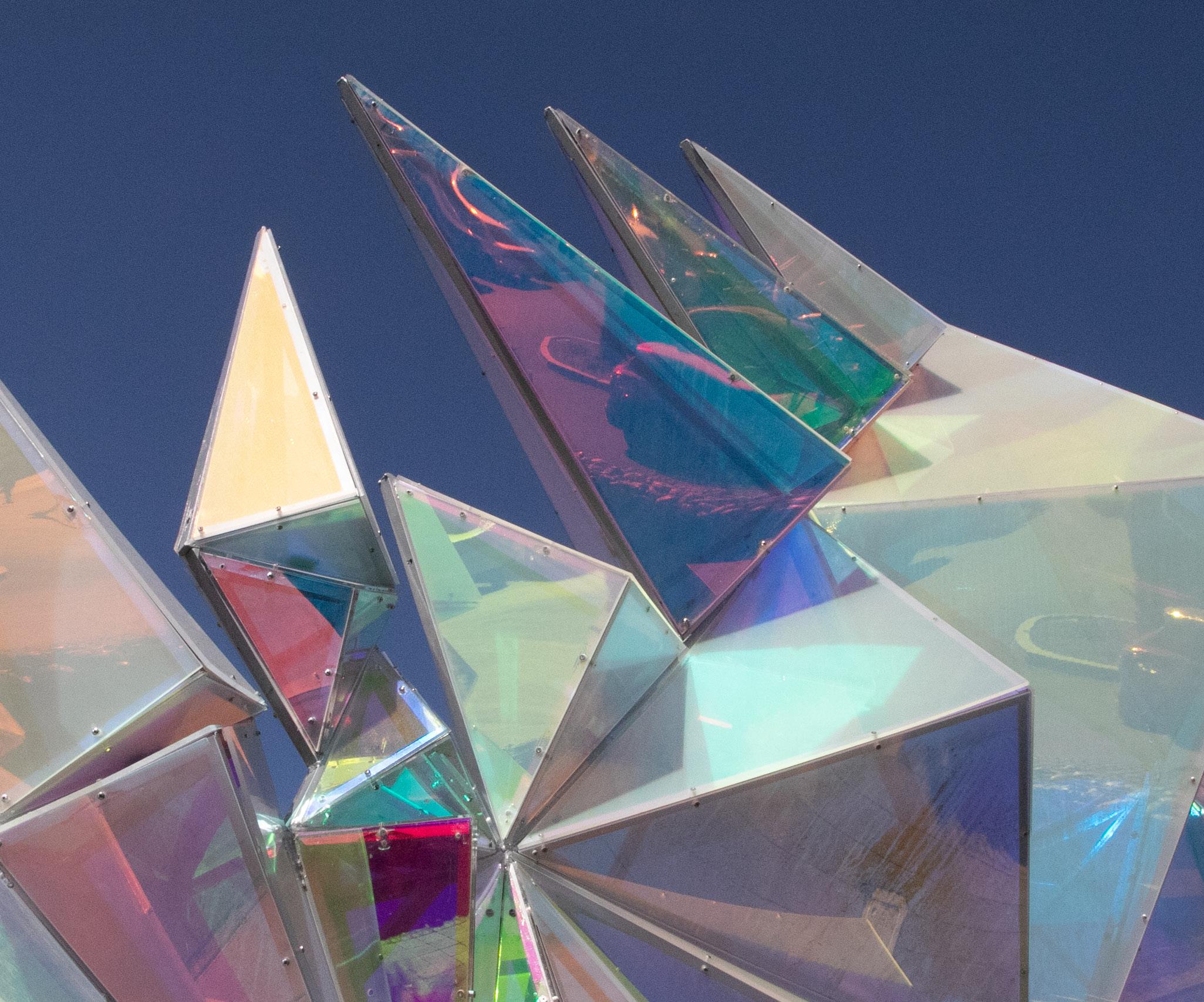
08 / THE LAS VEGAS ISSUE TRAVEL & STYLE
v
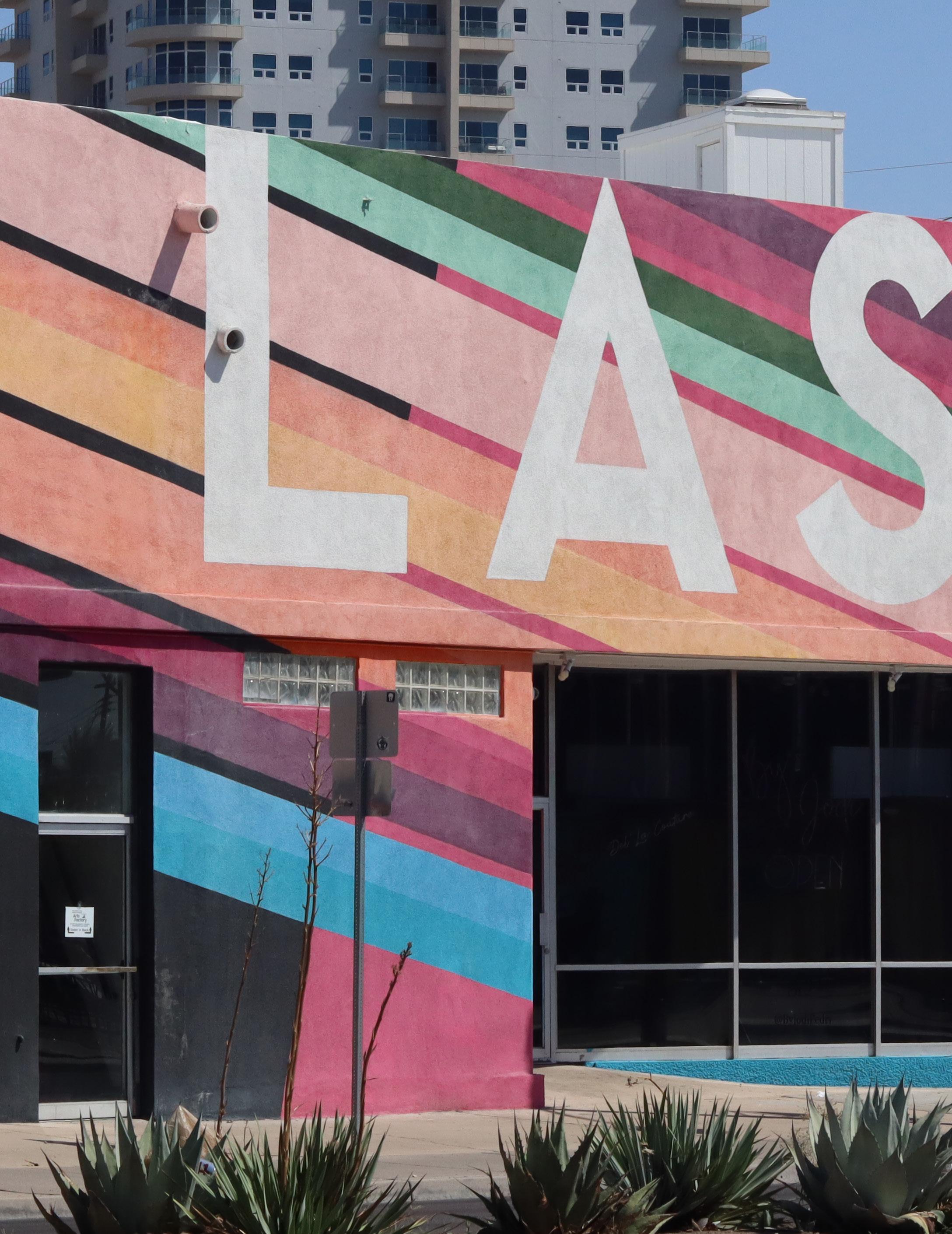
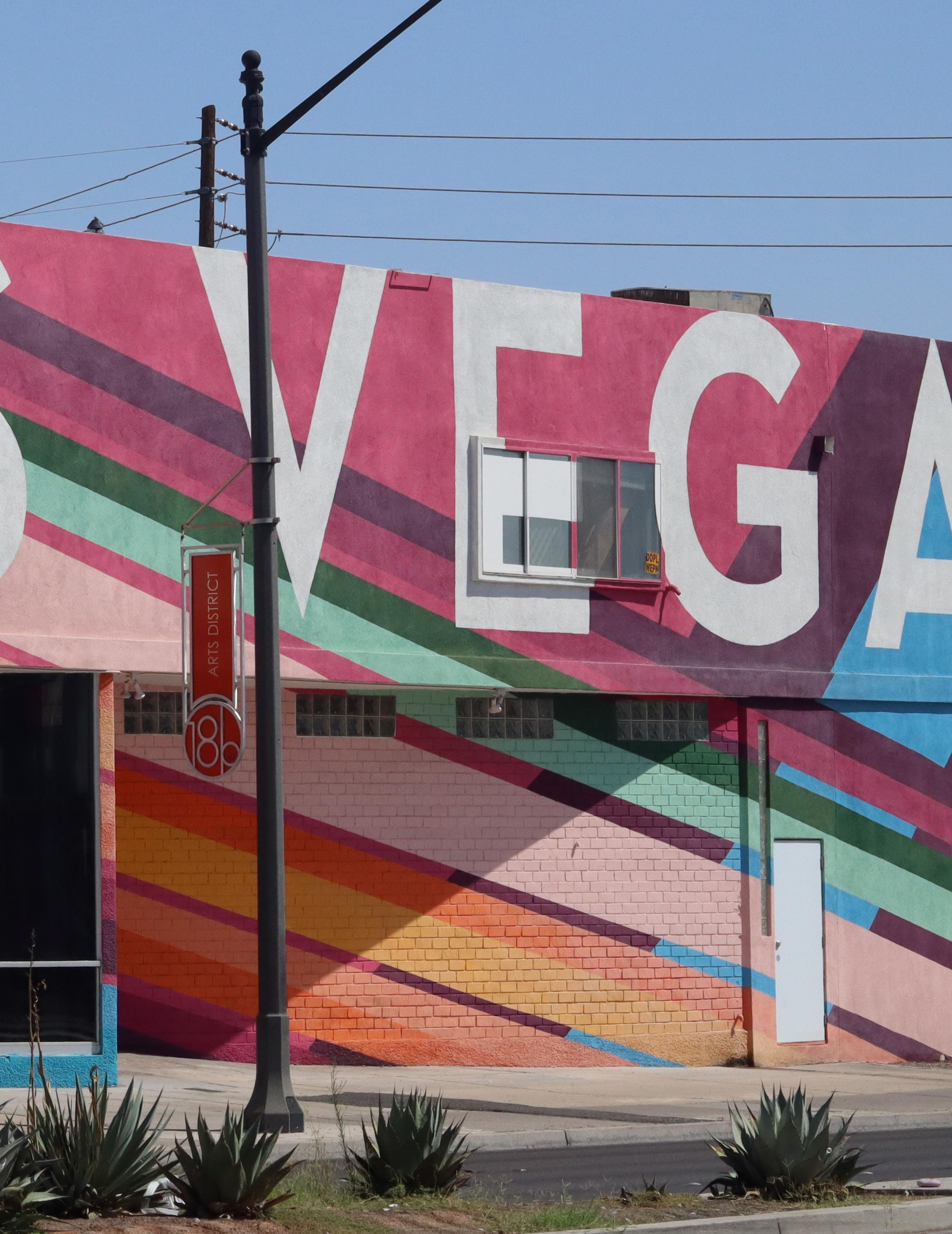
Co-Editor In Chief
Co-Executive Editor
Co-Executive Editor
Executive Photographer
Executive Designer
Business Manager
Events Manager
Media Manager
magazine
Apollonia Cuneo
Darice Wong
Catherine Chu
Miranda Li
William Fei
Christina Kan
James Nguyen
Nicole Ru
Shayla Madha
words
Audrey Sioeng
Catherine Chu
Kat Shok
Alexandra Garcia
Miranda Li
Nicole Ru
Niko Frost
Robin Ying
Sasha Shahinfar
Vivian Stacy
photos
Alisa Karesh
Anette Brecko
Apollonia Cuneo
Christina Kan
Eden Porras Harth
Emily Langton
James Nguyen
Lisi Ludwig
Niko Frost
Shayla Madha
William Fei
design
Christina Kan
Darice Wong
Haniqa Rahardjo
Hannah Zhuang
Ira Puri
Sakeena Baxamusa
6
MASTHEAD
Co-Editor In Chief
1
Las Vegas just might be the world’s most famous paradox. It’s a vibrant city stranded in the middle of the desert, and prior to the recent pandemic, one that could draw over 42 million visitors in a year. Its most popular attractions are borrowed motifs: a replica of the Eiffel Tower looms over the Strip, and iconic hotels evoke modern-day Venice and ancient Egypt. Add Vegas’ notorious nightlife and indulgent consumption to the mix, and the recipe for “Sin City” is seemingly complete. Yet our curiosity got the better of us; we were eager to see if “Sin City” was the whole story. Could there be more to Las Vegas than meets the eye?
Our trip this semester pushed us into a land of extremes. Our days were spent transitioning between sweltering heat and air-conditioned motel rooms set to 45 degrees Fahrenheit. Dilapidated buildings were juxtaposed with new developments. We observed natural light pour onto geological features but were penetrated by flashing neon lights in casinos a few hours later. We could not escape the consumerist face of Las Vegas — a place designed to lure you in with its garish displays, kitsch objects, artificial lights, and boundless forms of entertainment. Even so, we strangely admired the sheer existence of this city, one that thrives in the desert through adaptation and continuous reinvention so that it might trap its next prey. Las Vegas, unafraid to be itself, makes the traveler feel both wonder and disgust — a tension we grapple with in our magazine.
These pages are records of the eclectic spaces we traversed over one weekend, our earnest attempts to make sense of a city that defies all expectations, though we barely scratch the surface. You’ll find that we’ve continued to expand our Berkeley Connection articles in this issue, weaving distant experiences with local ones. We invite you to explore Las Vegas through our eyes, and hopefully, discover something about yourself in the process.
We’re beyond proud to present the eighth issue of our magazine, and we look forward to many more adventures as a club.
Safe Travels,
Apollonia Cuneo & Darice Wong
Co-Editors In Chief
LETTER FROM THE EDITORS
2
Ordinary Landscapes

En route to the Valley of Fire
words: William Fei
photos: William Fei
Arid Solace
Reflections in the Valley of Fire
words: Apollonia Cuneo
photos: Apollonia Cuneo, Christina Kan
25
Let’s Get Married In Vegas
A mirage of marriage in the desert
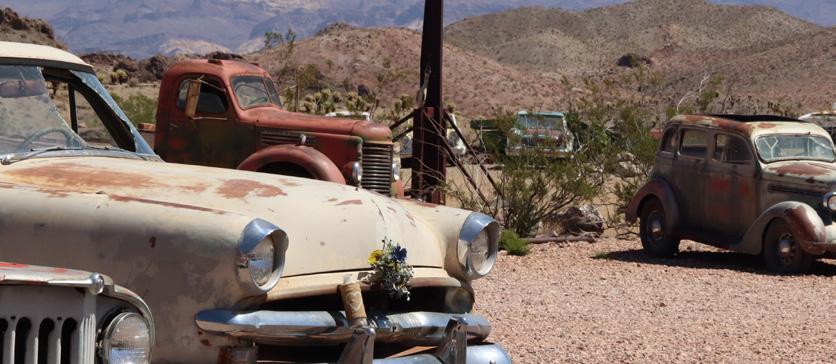


words: Miranda Li
photos: Eden Porras Harth, Lisi Ludwig
41
A Ruffled White Veil
Romance at the Palace of Fine Arts
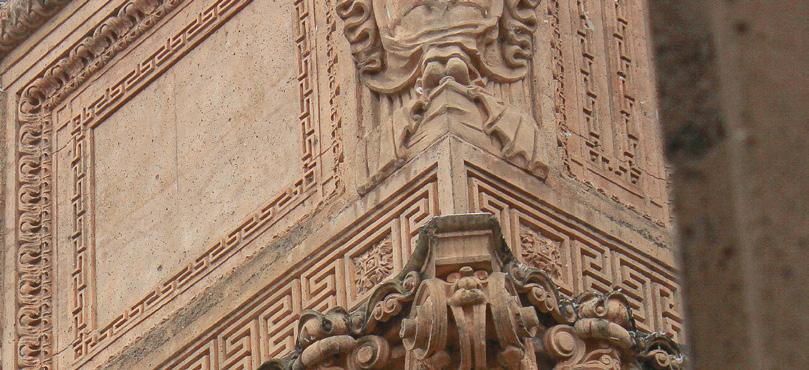
words: Catherine Chu
photos: Alisa Karesh
46
The Last of Us
Scenes from the Nelson Ghost Town
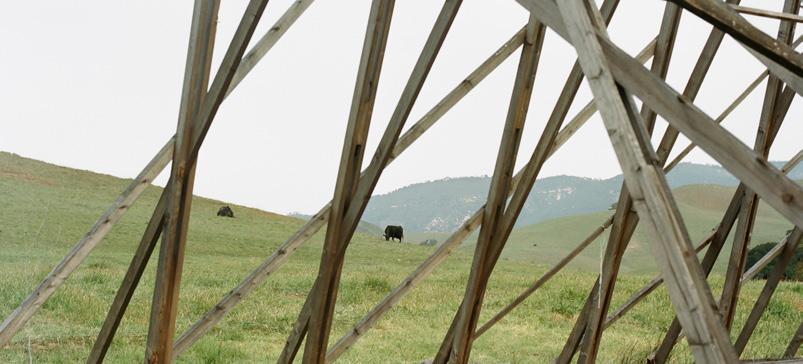
photos: Christina Kan
Making Space
Community at Vegas’ “master-planned” Chinatown
words: Darice Wong
photos: James Nguyen, Niko Frost
Dry As Hell
How Vegas gets its water against all

words: Kat Shok
photo: James Nguyen, Niko Frost
28
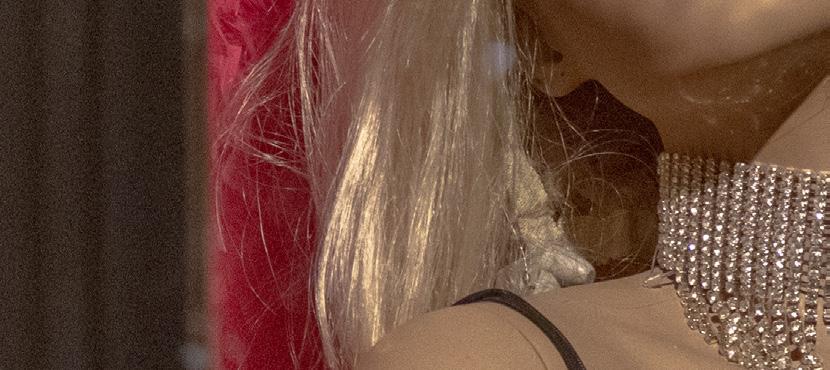
Sex & The (Sin) City
Under the scorching Vegas sun, a

words: Niko Frost
photos: James Nguyen, Niko Frost
50
Troubling Stickiness
A study of spaces and bodies stuck
words: Sasha Shahinfar
photos: Apollonia Cuneo
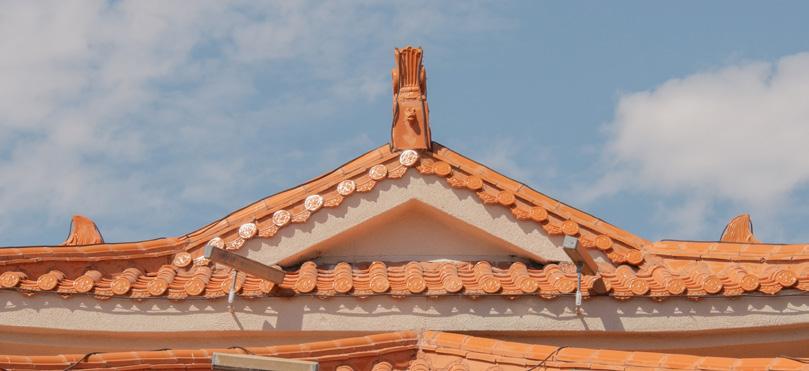



8 TABLE OF CONTENTS 5 7 11
21
3
odds and what it means
Light Semiotics
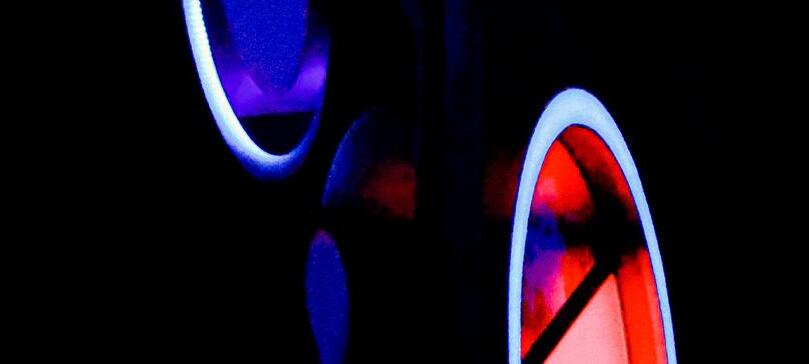
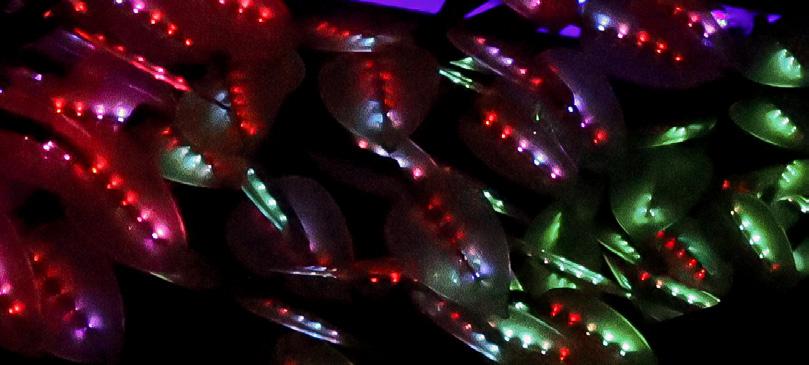
Notes on the flourescence of Las Vegas
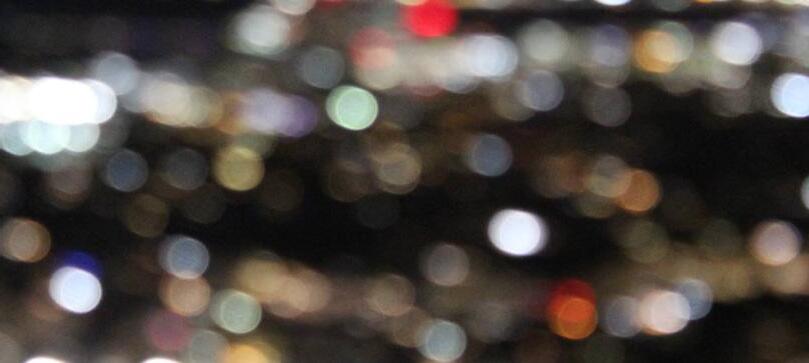
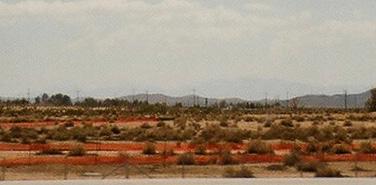
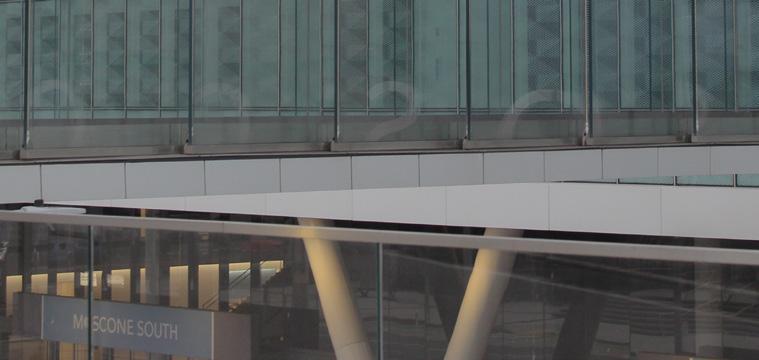
words: Alexandra Jade Garcia photos: Apollonia Cuneo
Passing Water, Under The Bridge
Seeking enlightenment at Point Cloud
words: Audrey Sioeng
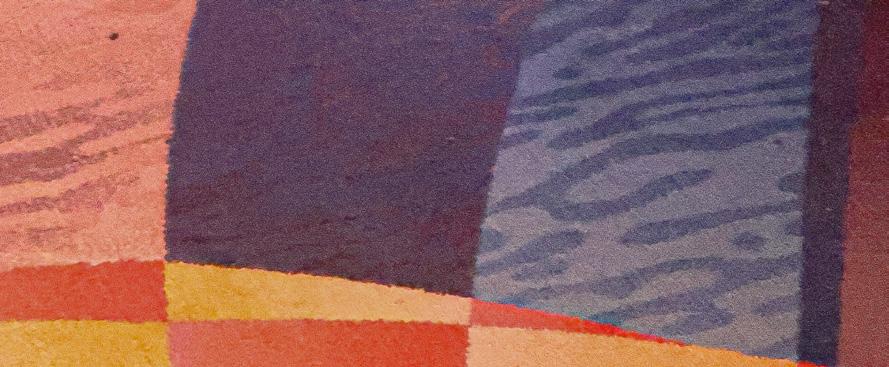
photos: Alisa Karesh
secret sexy oasis awaits you
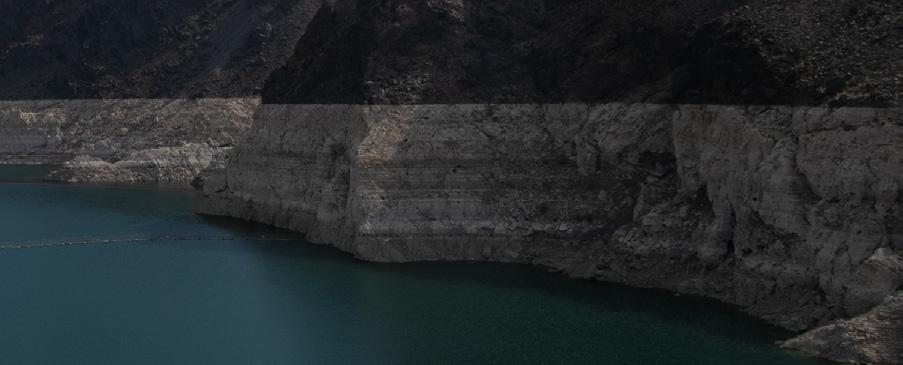
Timeless Treasures
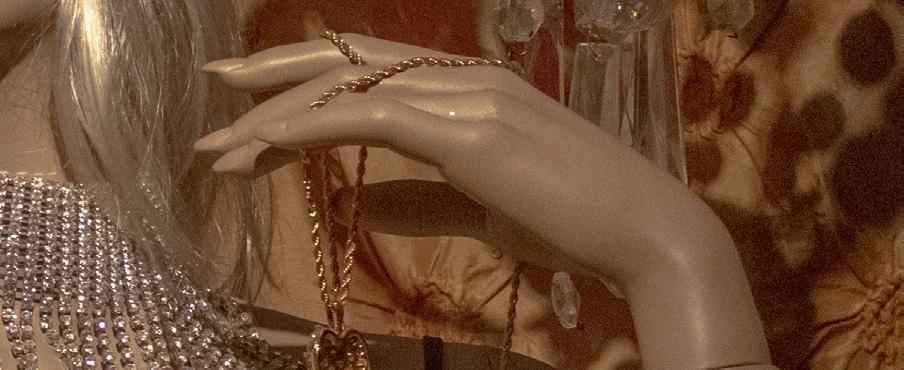
Reminiscing in the Antique Alley Mall
words: Nicole Ru photos: Christina Kan, Emily Langton, William Fei

54
in Vegas
Sonder
Grizzly Peak musings
words: Vivian Stacy photos: Shayla Madha
A Grand Garage Sale Hunt

The artistic productions within SF garages
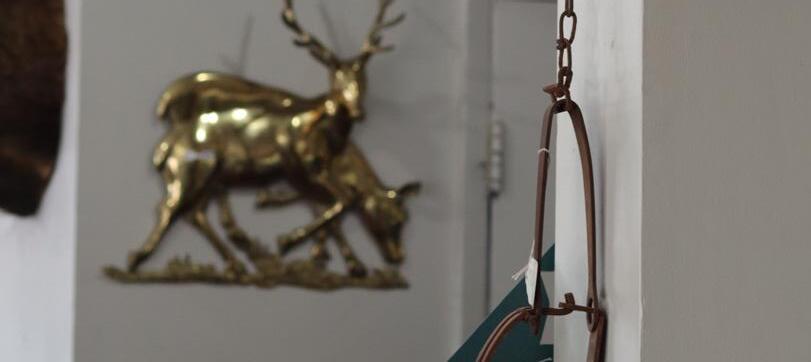
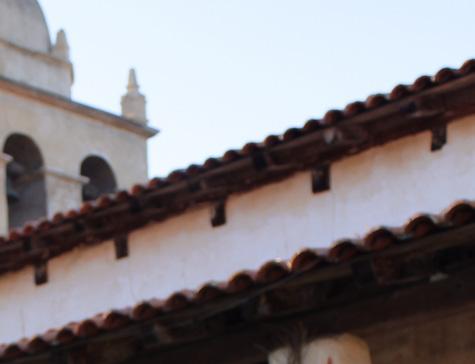

words: Robin Ying photos: Anette Brecko
57
Sinsatiable
A poem
words: Shayla Madha photos: Shayla Madha
15 18
33 37
4
ORDINARY LANDSCAPES
Chasing Wanderlust en route to the Valley of Fire
Ordinary Landscapes
En route to the Valley of Fire
Today, we leave Las Vegas behind us.
S in City is renowned for its bright lights and long nights, but yesterday we went to bed shortly after dusk. Now the dashboard reads 4:45 a.m. and we are already on the road, en route to the Valley of Fire.
We pull out of our motel directly onto the Las Vegas Strip, and immediately, we are engulfed in light. The gleam of crimson taillights guides our path as we drive slowly amidst two-lane traffic. In my peripheral, golden casino bulbs flash in a hypnotic rhythm. An overhead neon sign proudly displays Taco Bell Cantina: Open 24 Hours; underneath, I watch as small groups saunter or stumble through the inviting doors. Despite the absurdity of the hour, Vegas is awake as ever.
 William Fei design Hannah Zhuang
words William Fei photo William Fei design Hannah Zhuang
William Fei design Hannah Zhuang
words William Fei photo William Fei design Hannah Zhuang
NON-EDITOR CONTRIBUTIONS 5
Our GPS eventually navigates us out of the Strip and onto the Interstate. Almost immediately, it is clear we’re not in Vegas anymore. The traffic has thinned, the crowds have dispersed. These highway roads are decorated with simple Joshua trees, dotted only with the infrequent corner store and gas station.
Traveling farther from the light-polluting neon city, the blazing artificial flare gives way to a dim moonlight. I look upward, and my view of the glittering sky is unobstructed despite the faint glow of street lamps. It comes to me now that it is still night and that the world has not yet awakened.
I allow myself to fall into a trance, my eyes unalert, peaceful, following the lights.
Familiarity, finally. I eagerly welcome our return to these ordinary landscapes. To the comfort of spaciousness and solitude. To these roads, these fields, these places meant to be lived in. Though Vegas enchanted me for a moment, it is only within this expanse where I can rest.
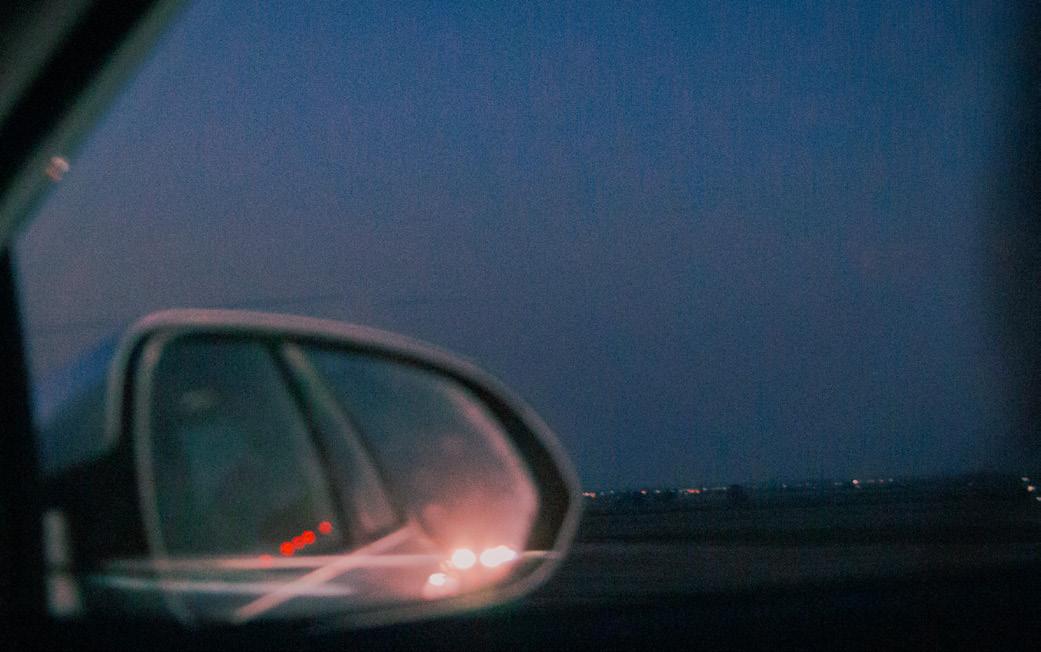
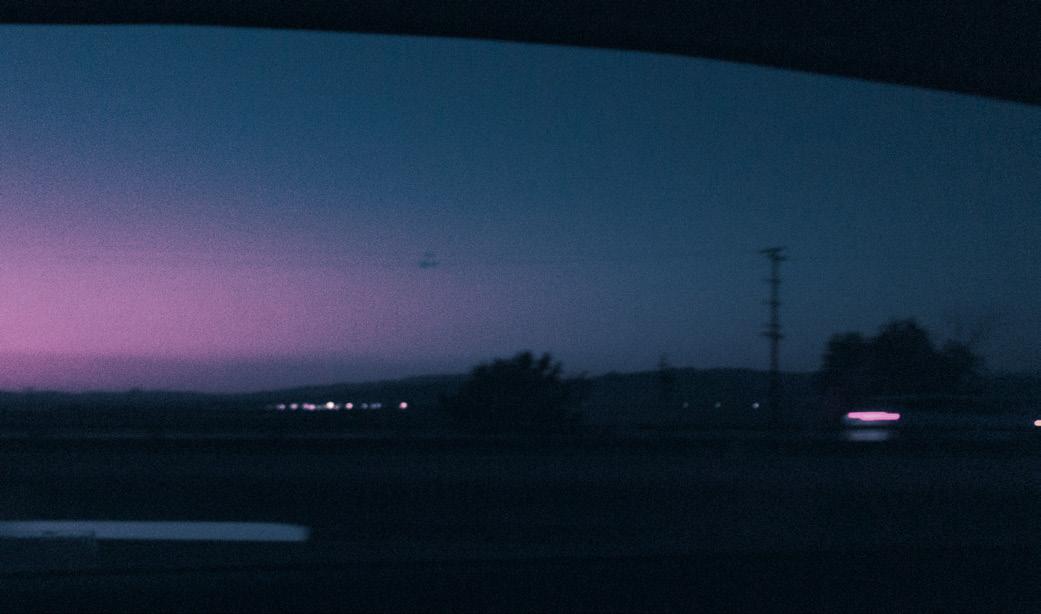
We arrive at the Valley of Fire in time for sunrise, where we are engulfed in brilliant sapphire, orange, and rosy hues. We park the car. We’ve made it. I let it all soak in. For the first time since arriving in Vegas, I feel like I belong.

INTERSTATE 15
VALLEY OF FIRE 6
LAS VEGAS
words
Apollonia Cuneo
photos
Apollonia Cuneo
Christina Kan
design
Hannah Zhuang
Arid Solace
Reflections in the Valley of Fire
With a crunch of my shoe into the gravelly floor below, out I step into the vast Mojave Desert. “Geology puts your life into context” — the words of a doctor who, unsolicited, shared his worldview before discharging me from the hospital — lingers in the still, hot air. He was an inspiring character who left a lasting impression on me despite our fleeting interactions. I felt empowered to take control of my mental health after our encounter, adopting breathing techniques and therapy as coping tools. I came to realize that, despite many stress-inducing unknowns in life, human existence is but a speck on the cosmic scale.

7 NON-EDITOR
CONTRIBUTIONS
The Valley of Fire developed over hundreds of millions of years: a ceaseless reshaping by shifting winds. Before humans stepped on this terrain, dinosaurs roamed the Earth. Will Las Vegas survive hundreds of millions years into the future? To grapple with our own impermanence we seem to carve our names into boulders and leave our mark by creating art. I want to capture the moment with my photographs. I do not care for the ephemeral man-made landmarks one can find on the strip. Pause.
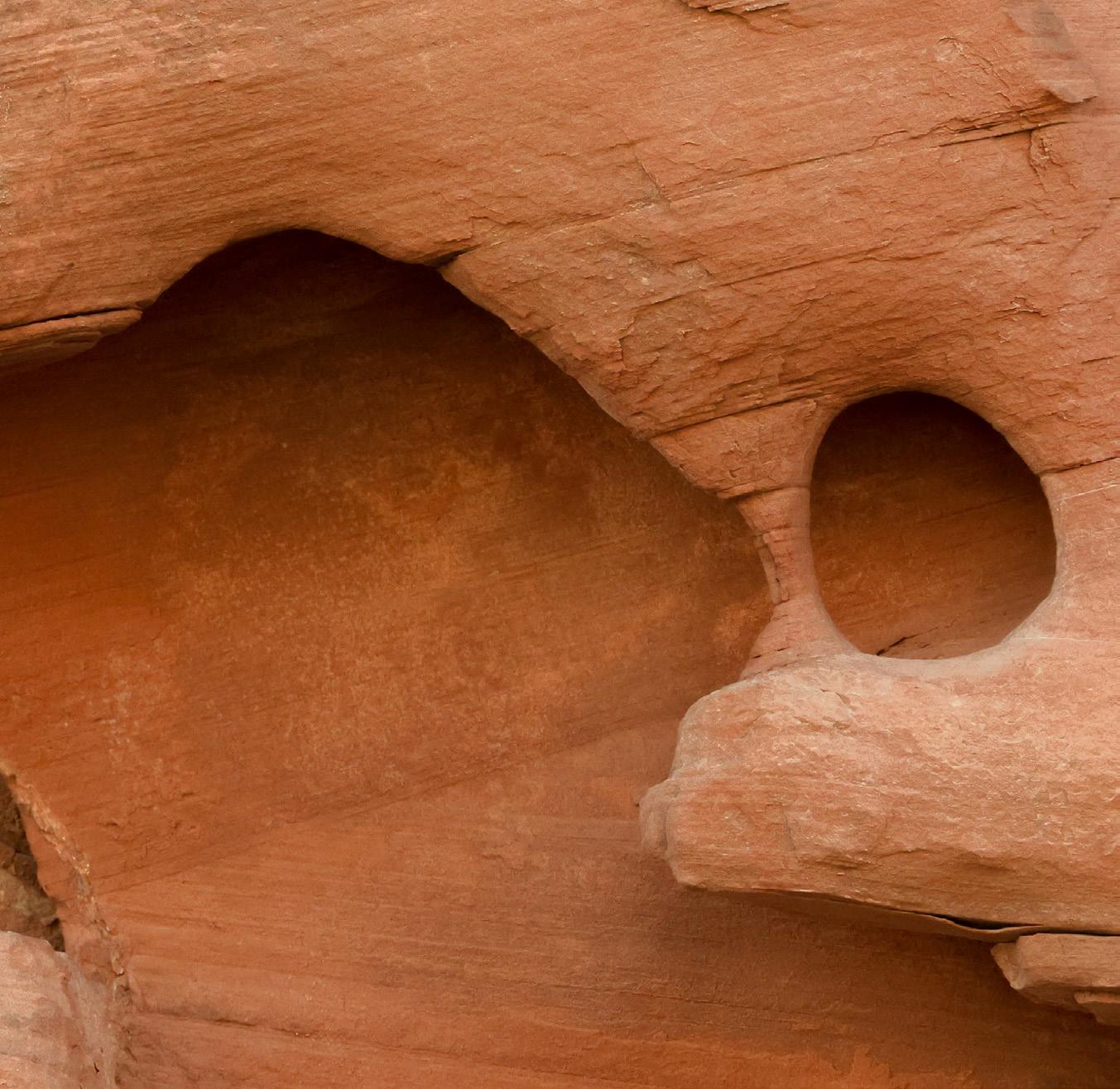
Inhale three seconds…hold…wooooosh.
Pause.
I am alone, alone with the steady rhythm of my footsteps and cyclical breathing. Towers of weathered sandstone span 360 degrees of panorama before transcending my field of vision. While shadowy darkness fills cavernous holes in rocky structures, taken as a whole, the canyon infused with iron minerals casts a perpetual red glow. It is as if I am suspended in time; motionless surroundings beckon a peaceful solitude for which I am grateful. Briefly interrupting, albeit warmly received, a blue-speckled lizard disappears and reappears like a magic trick from the rocks’ dark pockets.

I find myself subject to the gravitational pull of one particular formation isolated from the rest. It sucks me closer to its vertical surface in a trance. The variegated textures invoke an intrinsic fascination as I run my hand against its side. Smooth in some areas but jagged in others, protruding in some spots but sunken in others, its mesmerizing contradictions have inspired an entire sport. I understand why.
As a child, I found joy in collecting small things; I still do. My first love was rocks, tumbled and polished or washed ashore. I would grasp, squeeze, and turn them over in my hand, trying to imagine where they originated from. Out of place though resilient, these fragments of distant geographies take on new meaning. As our humble and wise guides, they connect us to faraway lands and transport us into the past. The expanse of the universe does not frighten me. I am comforted by the presence of these small yet significant rocks.
8

9
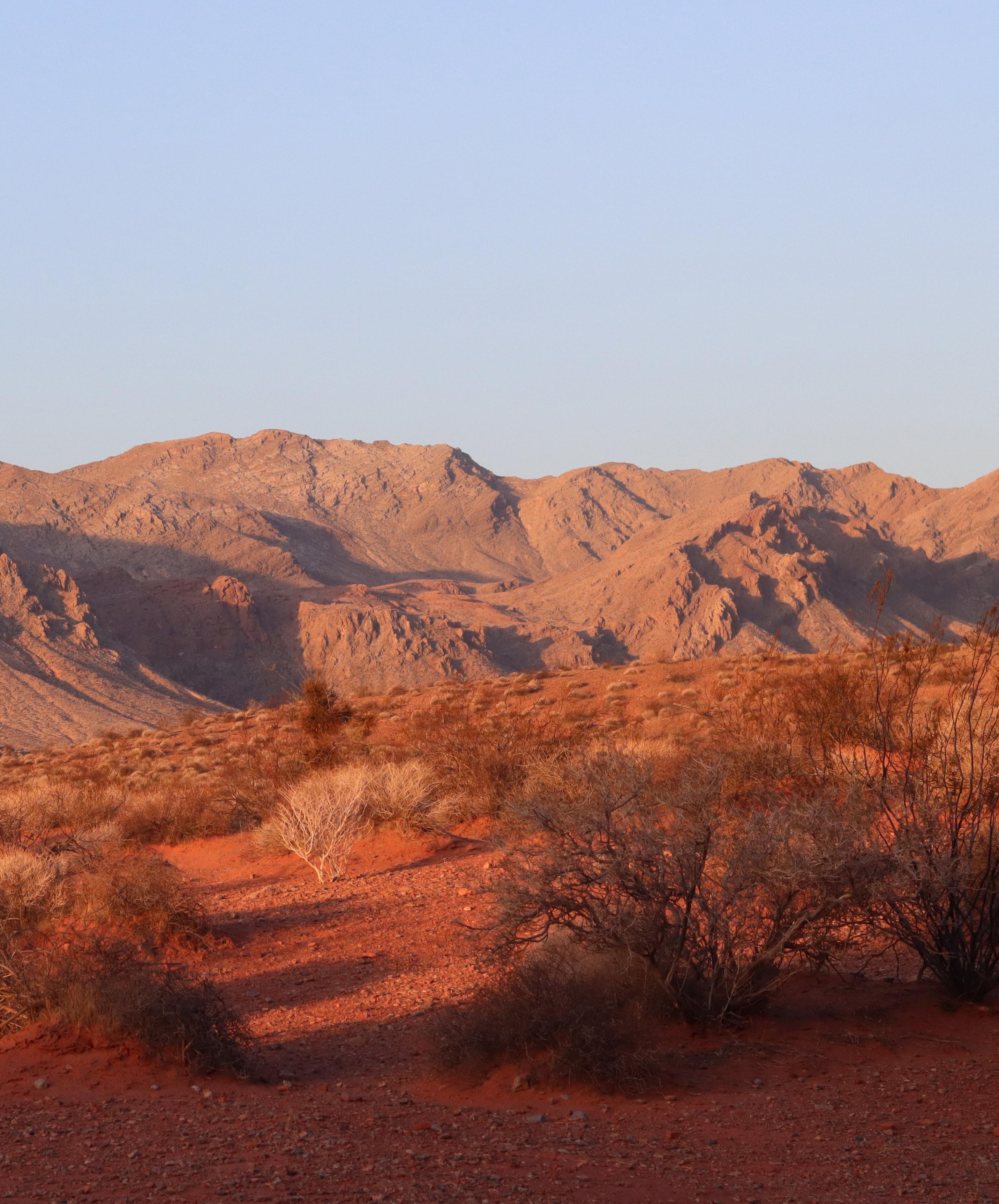
10
Dry As Hell
How Vegas gets its water against all odds



words Kat
photos
design
above
Shok
James Nguyen Niko Frost
Darice Wong
Lake Mead
11
Vegas is an impossible city. To put it frankly, it shouldn’t exist.
The road to Vegas feels unreal — rolling, green California landscapes lose altitude and all traces of moisture until only husky Joshua trees, stubborn cacti, and miles of dust are all that remain. Then suddenly, greeted by a light-up “Welcome to Las Vegas” sign, you enter the bright, bountiful, irresponsibly developed Sin City.
Over 1.5 million people live in and around Las Vegas, in the middle of the damn Mojave Desert, while almost 40 million people visit annually to indulge. Innumerable and enormous casinos, wellstocked resorts, and entire themed districts — if you can think of it, it probably exists in Vegas. Fine dining? Check. Rooftop pools? Check. A TV the size of an entire floor? Checkity check.
Driven by human desire, it is no wonder that Vegas has grown to
be the behemoth that it is. Throughout this growth, the region has boasted a stunning dryness — but money can make anything happen, and money is the lifeblood of the city, making life happen when rain can’t.
Vegas receives just over four inches of rain a year, while the US average is 38. So in mapping the hydrating arteries of the city, one has to examine the area around Nevada to understand where all the water originates. One inward flow is Nevada’s supply of groundwater, which Vegas sips from. Another is the Colorado River, which Vegas absolutely gulps from, by way of the architectural phenomena Lake Mead and the Hoover Dam on the Nevada-Arizona border.
There wasn’t enough water in the area for people to populate it, so we changed the entire surrounding landscape with a dam. As of September, Lake Mead was at its lowest capacity on record, at under

12
27%. While some of the blame can be placed on lower-than-average rains, this dryness is also fed by the insistent demand from Las Vegas’ thirsty patrons.
Water-wise, Lake Mead has historically held a peak of 9.3 trillion gallons. But today, the lake looks more like a mostly-drained bathtub with a clearly rust-stained waterline. Dryness dominates the top of the lake, creating a border that makes one’s throat itch. Cracked earth and desolate brown canyons characterize the area around the sad man-made pool. Old docks float on earth, the lasting memory of years with plentiful rain. They likely will never float on water again.
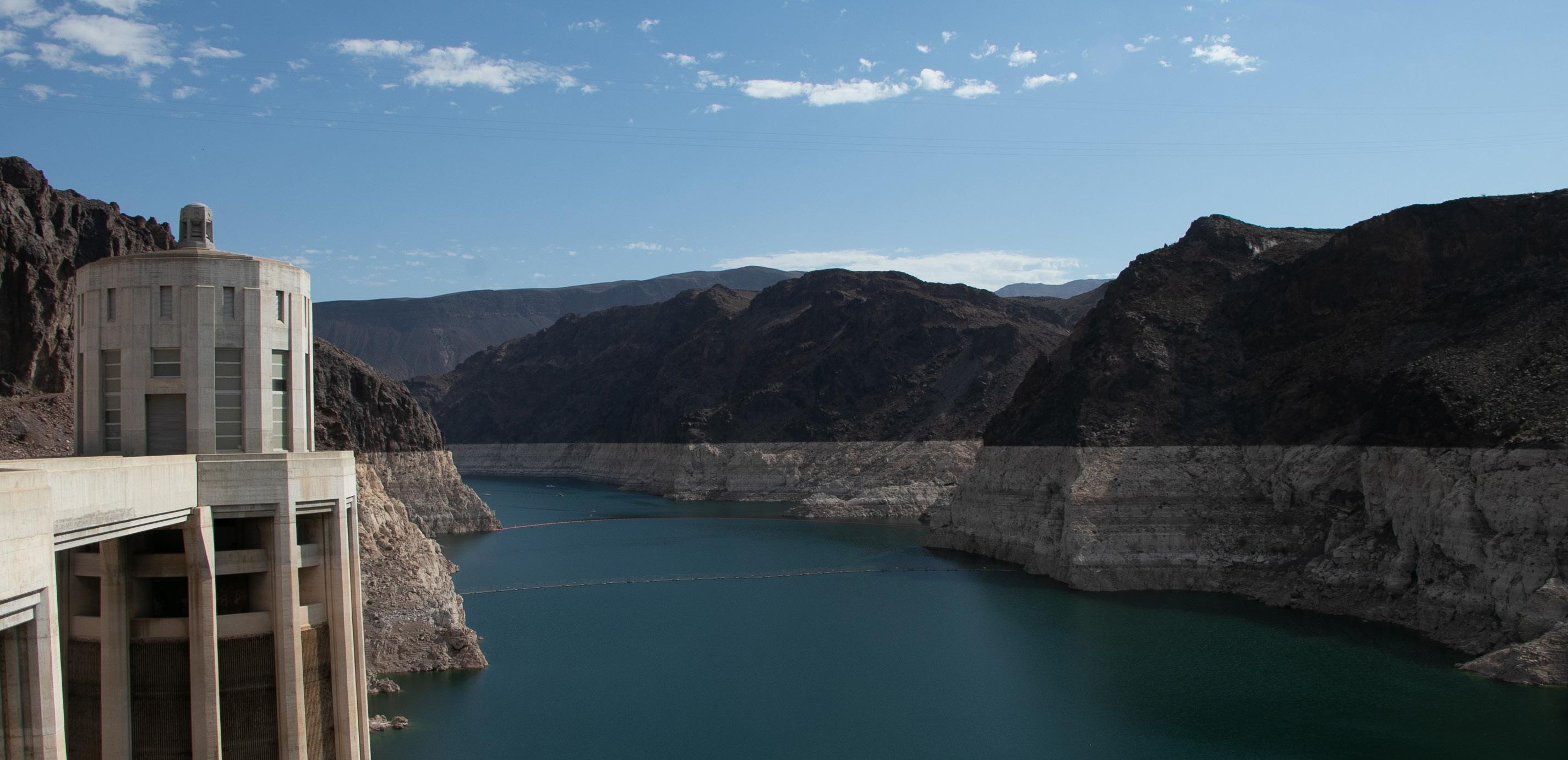
After a blisteringly lengthy summer, Clark County, which contains Vegas, is in severe drought. You almost wouldn’t know it, though, if you were walking the streets of the city. In the terraformed city of sin, the show must go on.
The 22 million gallons in the Bellagio fountain are still musically sprayed about every half-hour. The Roman-esque canals of The Venetian are still full enough for touristy gondola boats to sail down.
The estimated 200,000 swimming pools in Las Vegas are still topped up, although now Clark County has graciously limited their sizes, so they can’t be bigger than three garages put together.
According to the City of Las Vegas website, the metropolis is “recognized as a national leader in environmental sustainability,” including water conservation and remarkable water recycling systems that recovers about 40% of water used in Vegas’ hotels. This is undoubtedly, impressively true — if you’re going to build an adult playground in the desert, you better at least be efficient with your environmental transgressions.
Yet in the long run, summers will only get drier; rains will only get sparser. But Las Vegas isn’t going anywhere, no way no how. Its economy is too big, its staff is too large, its sprawl is too uncontained to be budged.
But the fact of the matter is that Vegas shouldn’t exist. Tips like taking shorter showers or only using a fully loaded dishwasher can only do so much. The Las Vegas real estate market is booming, with
13
new communities in development around all of its existing suburbs. Whether the environment is able to support them or not, Vegas appeals to the people and the people will keep coming.


And people will keep coming because we’re greedy. We’re greedy, and we want what’s best for ourselves and our families. The average Vegas resident is thinking about paying their rent, buying their groceries, maybe a night out. In the whirl of our daily lives, we don’t have the time, the energy, or the environmental selflessness to think about where the water we’re drinking comes from.
None of this is immoral or illogical. We want not just to survive but to really live our lives, experience everything we can and give as many opportunities as possible to our loved ones. None of that is wrong, and none of it can be stopped.

There’s nothing that one article in an indie travel publication can do to change how the world thinks about Las Vegas. But the least we can do is draw attention to things that have repercussions not just on us, but on everything in the environments around us, so that we can still live our damn lives.

above A canal in The Venetian left page Hoover Dam 14
Light Semiotics
A collection of notes on the fluorescence of Las Vegas
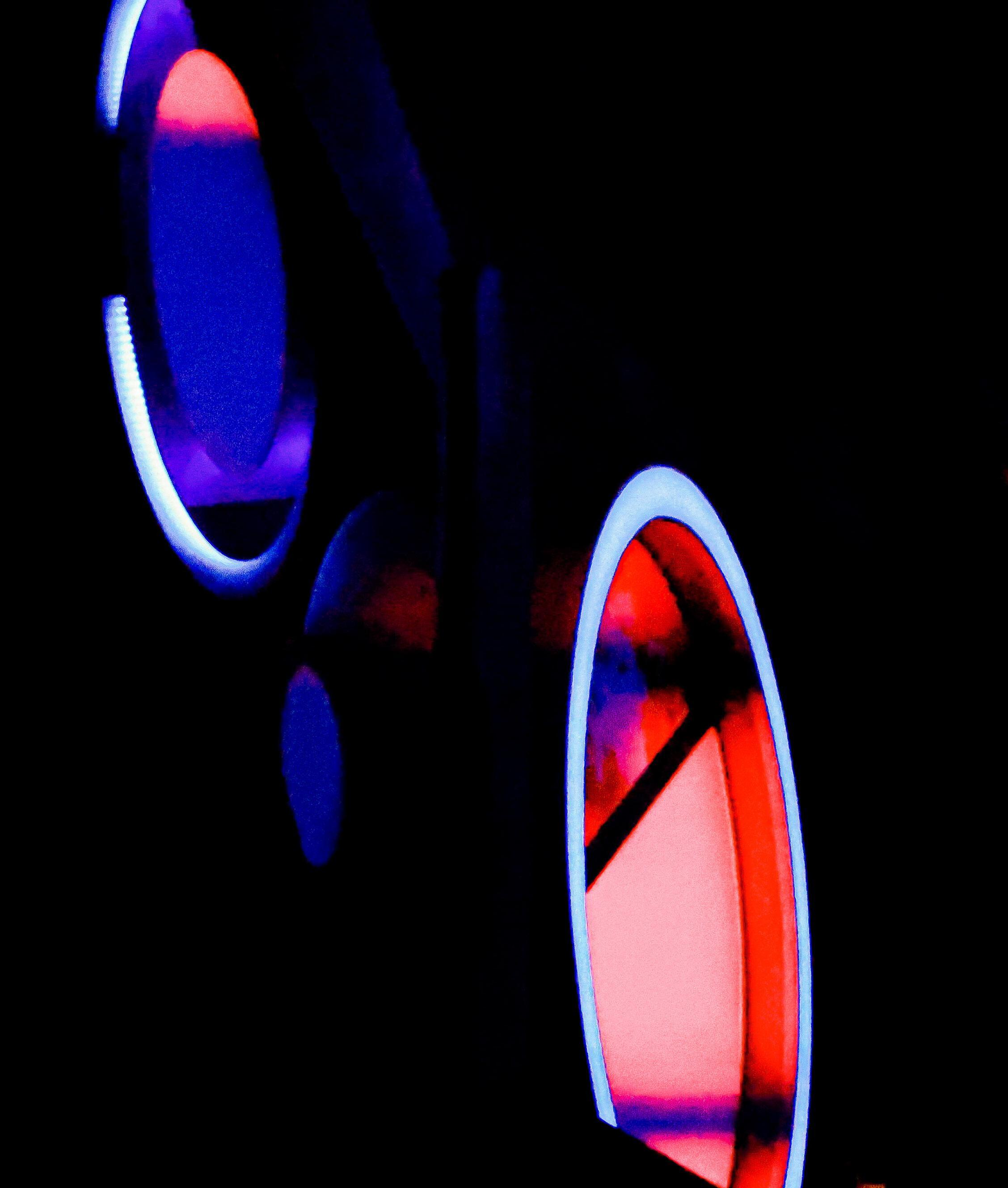 words Alexandra Jade Garcia
photos Apollonia Cuneo design
words Alexandra Jade Garcia
photos Apollonia Cuneo design
15
Haniqa Rahandjo
Below is a collection of notes observing the use of light in Las Vegas, NV. I observe the notorious idea of “Vegas lights” through an exploration of semiotics — the use of signs and symbols and their interpretations — to understand how Vegas lights capture our attention, enamor our minds, and decide our experience.
Vegas lights are incessant.
After all, the city is renowned for its glowing light fixtures — the ones that follow tourists at every turn, guiding their next step to every attraction within a five-mile radius. Each establishment seems to be accompanied by a larger-than-life neon sign to aggrandize its existence, or adorned with flashing bulbs as if to preach to the world:
“A must see, once in a lifetime!”
“World famous!”
“Welcome to Fabulous Las Vegas Nevada”
As our car speeds closer and closer to the glaring metropolis ahead, I take note of just how incessant Vegas lights can be.
Vegas lights are plugged in at all times.
The first stop we make once entering city limits is at a gas station in Primm Valley. It neighbors Whiskey Pete’s, a hotel and casino whose enormous signage shines woefully, juxtaposed against a nearly empty parking lot.
W
- H - I - S - K - E - Y
Each letter glares so brightly, every edge of the walls and roof covered in blinking lights. I’ve somehow convinced myself there’s not a single tourist inside, finding it eerie that all of the energy being used to power this massive structure is on display, yet not a single soul appears to be looking.
Massive light structures require massive amounts of energy, even if for an audience of none.
Vegas lights create a sense of escape.
Indoor destinations prove to be our sanctuary on this trip, as the temperatures of Las Vegas climb upwards of 115 degrees. Area 15 presents itself as an optimal destination to hide from the heat and continue this exploration of light; it’s an entertainment center complete with virtual reality and the expansive Omega Mart, an art installation that advertises grand light anomalies and optical illusions.
The promises of Area 15 fall short for my college student wallet, but it’s still a space rich in observation. Neon paint radiates along the walls and a massive tree with LED leaves sits in the middle of the room; everything is accentuated under the dim backlight. Above me, a zipline propels visitors in a cramped loop around the premise. Around me, visitors are pointing devices at walls, on some sort of virtual reality quest. In front of me, a poster reads: “Reality is not enough.”
Area 15 exhibits a certain use of light that enables everybody inside to immerse themselves in different worlds. The vivid neon invites, the dim blacklight engulfs, and the digital bluelight entraps, all at once. It’s an experience that speaks to the greater lengths of my perspective of Las Vegas: a commercial escape conveyed to its viewers through effervescent screens and promises of entertainment never seen before.
Indoor lights in Vegas can be just as or even more potent than the signage outdoors.
Vegas lights are convincing vendors.
In the Fremont East District, Vegas lights become as visceral as ever. The district embodies everything I envisioned Las Vegas to be, from the neon martini that marks the entrance to the colossal LED arch that extends across the entire pedestrian mall.
On our second and last night in Las Vegas, a low buzz greets me as we make our way toward Fremont Street — the sound of neon running through tubes, the active fluorescence above my head.
The arrival of neon in Las Vegas isn’t a coincidence, and more importantly, neither is its use. Brought about by the abundance of electricity that was needed for the construction of the Hoover Dam, the iconic status of neon signage has become synonymous
16
with the idea of the city itself. Neon sealed the fate of Las Vegas as a tourist destination; its luminescent glow advertises everything this city has to offer.
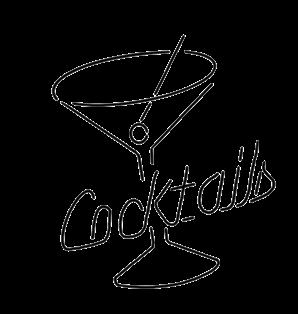
I see the Fremont East Experience as an epicenter of such advertisements. Jackpots at casinos, fancy cocktails at bars, even women at strip clubs — they are all selling points encompassed under the incessantly bright, arched digital screen I can’t seem to look away from. A city that never sleeps, I suppose, is one that vends instead.
Vegas lights have shown me that if your message shines bright enough, you can try selling almost anything.
Vegas lights signal attraction.

These selling points are only magnified as our night continues along the Strip. Attraction is everywhere, communicated through electronic billboards of musical residencies, neon lettering plastered upon buildings, and the 5,000 lights it takes to ignite the Bellagio’s water fountain. Vegas lights burn with such an intense brightness that they coerce visitors into visual conversation, every sign persuading them to engage with the endless forms of entertainment the Strip provides.
Human behavior is dependent on our interpretation of the signs and symbols that surround us. Every sign in Las Vegas is telling its tourists where to go and what to see, eliciting patterns of consumerism, materialism, gambling, and indulgence. Vegas lights, in all of their various forms, augment these messages with every beaming light fixture that works to capture the attention of bystanders, seduce them into the nearest available attraction, and sell them the most extravagant experience.
Much like the electricity that powers a light, the promise of attraction powers Las Vegas.

Vegas lights evolve with time.
My short time in Las Vegas has exposed me to the multitude of ways the city uses light and energy. I’ve come to learn that the history of Vegas lights isn’t linear; the pervasiveness of neon has been diluted over the past decades as the city evolves to use cheaper methods of lighting such as LED. Vegas lights reflect human behavior once more — we are constantly trying to find the most efficient models for life at the cheapest price.
This trip coincided with record-breaking levels of heat in Las Vegas, leaving me to consider our own transformation. I wonder if we’ll ever shift away from our obsession with consumption, escape, and stimulation. I wonder if we’ll be able to shift our understanding of light outside the lens of attraction to instead illuminate the reality of the changing world around us.
To visit Las Vegas is to visit a city where experience has been predetermined for you. Beyond its physical attractions and promises, Las Vegas imposes a mindset you must take on during your stay, distracting us from its increasing commercialization and that of our own. But observing Vegas lights has provided me a different experience, with different messages: Vegas lights are incessant; Vegas lights are plugged in at all times; Vegas lights create a sense of escape; Vegas lights are convincing vendors; Vegas lights signal attraction; Vegas lights evolve with time.
17
Passing Water, Under the Bridge
Seeking enlightenment at Point Cloud
Like many large cities, San Francisco is a city of lights. Today is one of those classic SF days where the world is washed in gray and damply hung out to embrace the drowsy fog. As the sun slips below the seemingly ever-present cloud layer, the blare of lights I had previously blocked out begins to seep into consciousness: the red flare of the brake lights, the transitions of red-green-yellow-red-redred traffic lights, blinking orange numbers and hands counting down the crosswalks, the glow of the various neon restaurant signage. Each of them begs you to pay attention: look here, look here, look here.

It’s easy to lose sight of the humanity of this place where the lights scream and cars cannot seem to help themselves when they see the opportunity to honk and cut traffic, which is ironic seeing as this
haze of light is a direct result of humanity’s chaotic addiction to convenience.
After what feels like eons, someone spots our destination, Point Cloud. “Quick, this is all you’re getting,” Shayla jokes as our faces gravitate towards the gleam of the windows. Shrinking into my car seat and contorting my neck to catch a glimpse of the installation through the front windshield, I hold my breath, bracing. A part of me already knows that it is a very real possibility that this will be a disappointment. Eighteen years, and already the pessimist in me has taught my imagination how to stand down. A quick warm blur of a rainbow greets me, not quite standing out in this city of light. We could’ve easily passed it.
THE BERKELEY CONNECTION
words Audrey Sioeng
photos
Alisa Karesh design
Ira Puri
18
When we get out of the car, the switch feels instant. The world lights up, and strangely enough, even the clouds feel brighter. Perhaps, I think to myself, this will change everything. Because that’s what light does, even without us knowing. Everyday we mold light to our convenience as we pass through the various parts of our day. The flick of light switches, tilt of the blinds, clicking of flashlights. A warmly lit cafe for studying, a darkened bedroom for afternoon naps, an illuminated hiking path to our next adventure.
“Try to see it in a different light,” we say to the pessimists in our lives. Or perhaps the optimists say to us.


The bridge, now that my eyes can dwell on its colors, still leaves behind a flavor of disappointment. The suspended poles from the roof each hold 18 colored lights that coalesce into a subtle ombre effect, the soft sunset shades of honey, marigold, cantaloupe, fuschia, and violet muddling in contrast with the reflective teal of the Moscone Center windows behind and the cool greys of the day. It is trying so hard to be something beautiful, something of value above the few stray pedestrians and cars that wander under its gaze. Above a mostly empty street, an electronic dance music festival’s hum pulses in my shoes several blocks away to make up for the deafening silence of this exhibit. I look at my carmates, apologetic — I feel lied to, I thought this would be cooler, this is embarrassing.
Peering through the glass one last time before we leave, what arrests me is the reflection of the lights on the other side of the glass. They remind me of skyscrapers — or rather, the memory associated with driving past them at night and counting the lit windows while realizing on the other side of every single one, there are people living their own lives, completely unaware of my own. In my notes app, I type “Light, as a symbol and reminder of life.”
Point Cloud, as a part of the Illuminate SF initiative, seeks to celebrate light as a form of art and support creative innovation in the city. From a purely functional point of view, light allows us to be productive through the dark hours of the day. However, on a deeper level, the encompassing halo of luminescence that is an
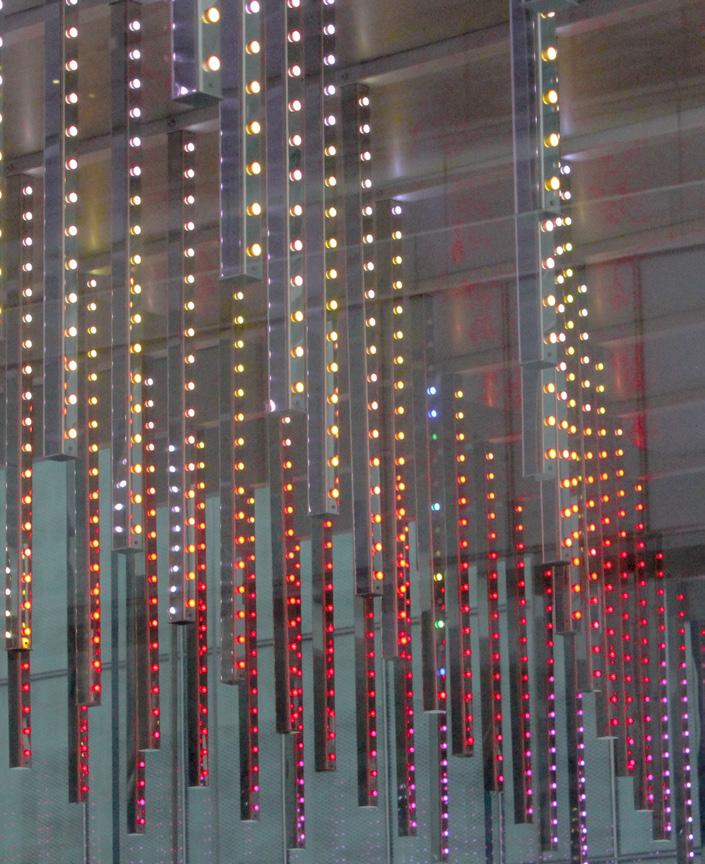 Point Cloud
Point Cloud
19
“Light is utilized to invoke a sense of wonder, especially when presented on a large scale.”
unmistakable hallmark of every city is directly correlated to the density of lives slowly burning into the night.
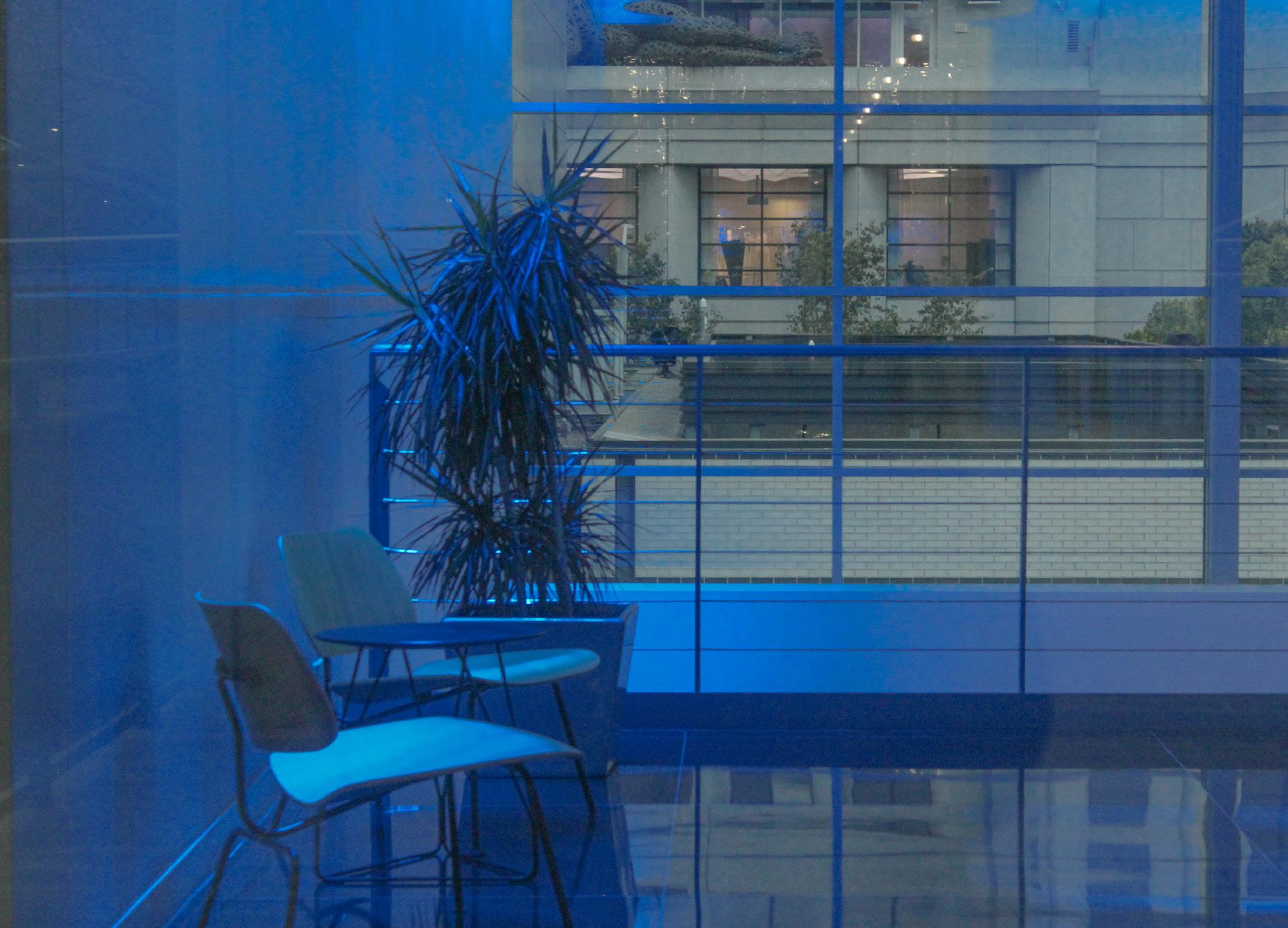
Humanity’s fascination with light is embedded in our collective consciousness. People all over the world study the extraterrestrial lights in the sky to learn more about galaxies beyond our own. Others make the trip to the Arctic and Antarctic circles to simply catch a glimpse of the beautiful, but fickle, auroras. And on top of that, even more people perch on the roofs of their cars, huddled on picnic blankets, to watch fireworks bloom in the night sky. Light is utilized to invoke a sense of wonder, especially when presented on a large scale. Similarly, light installations like Point Cloud in the Illuminate SF initiative also seek to inspire a sense of awe and selfreflection.
As I turn away from the bridge and pass under it for a final time, I reach a sense of calm. Art is subjective, and I am allowed to not feel inspired by this particular piece. Whether it’s because the sky was not dark enough, or my expectations were too high, my experience
was still valid, true to me. It’s not to say the structure was not beautiful or that I was not a qualified observer — once again, we simply coexist, passing one another without much incident.
In a book I recently read, the narrator ponders for a moment on Dunbar’s number, a theory that states we can only maintain a network of around 150 people at a time. In the few months since I first arrived in Berkeley, I’ve become keenly aware of how much potential each and every person I pass by has. Each classmate, each hallmate, each stranger I pass throughout my day. Every person I once saw in those skyscraper windows. And yet, I pass by so many of them, most times without a second thought. Not every relationship will ever reach its full potential, which makes every relationship that we forge, explore, and carry with us, that much more impactful.
On the car ride back to Berkeley, I watch the lights again and pick up some more to add to my metaphorical pockets. Streetlamps. Headlights. Eventually, I stop looking. I pass them by and in their own way, they pass me.
20
Let’s Get Married In Vegas
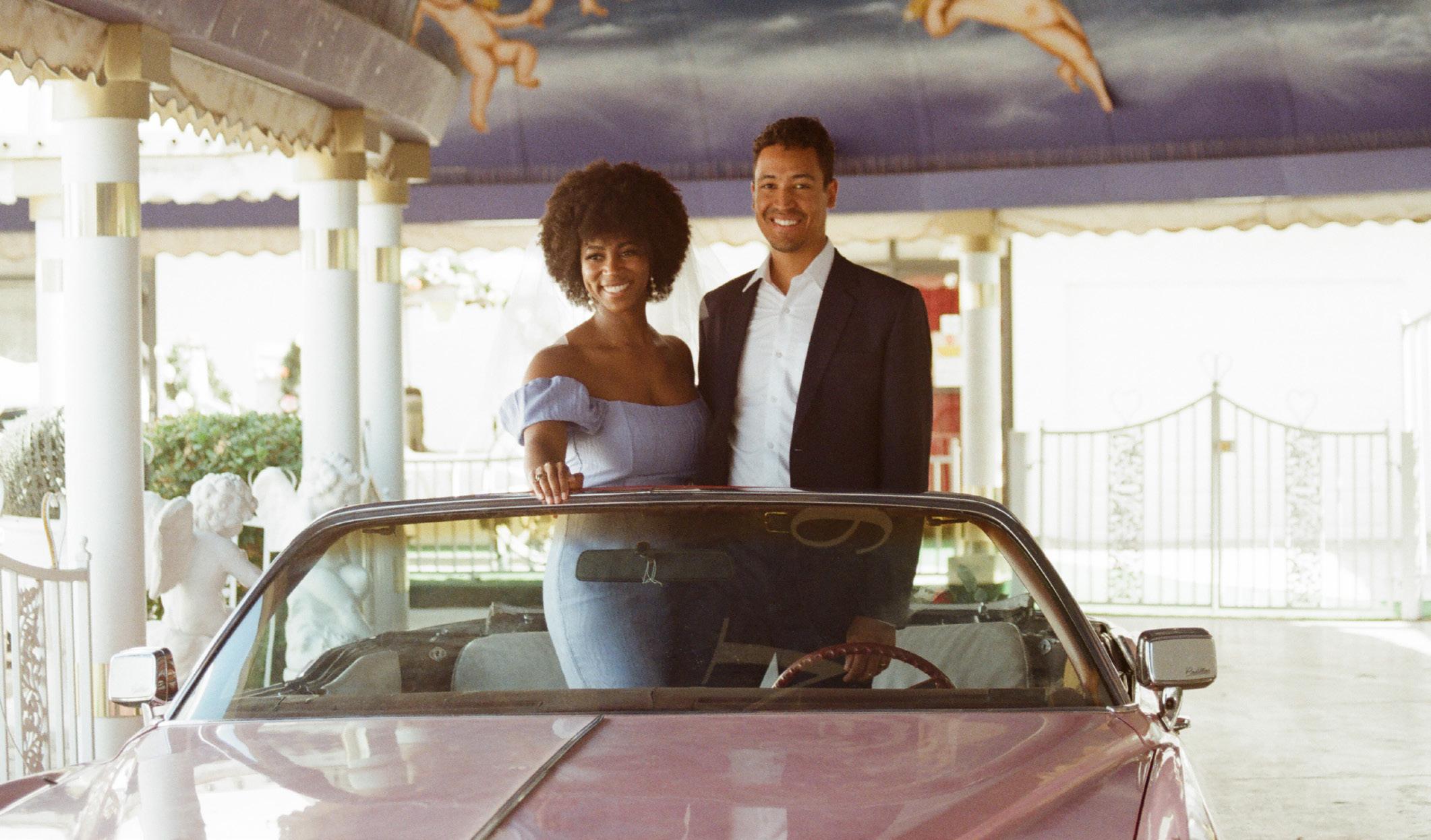
words Miranda Li photos Eden Porras Harth Lisi Ludwig design Sakeena Baxamusa
mirage of marriage in the desert 21
A
Let’s get married in Vegas and wish away our worries and go to sleep happy and free. Let’s dream of spontaneity and dance, melt, evaporate in the 112 degree heat. Let’s sleep and dream and be.
Asweltering two-minute walk down the Strip there is a drive-through wedding window. A sweltering two-minute walk, 75 dollars, and a license is all we need to be legally married. It’s a whispered challenge, an emboldening dare to embody the persona of where we’ve arrived. I find it hard to refuse.
Declare experiences as currency and crown Vegas king. Parade in riches — days dissolving into nights marrying into days of casino craze, unimaginable nightlife, high-stakes decisions made in split seconds in an alcohol-fueled euphoria.
Yet in a city all about spectacle, a Las Vegas wedding is anything but.


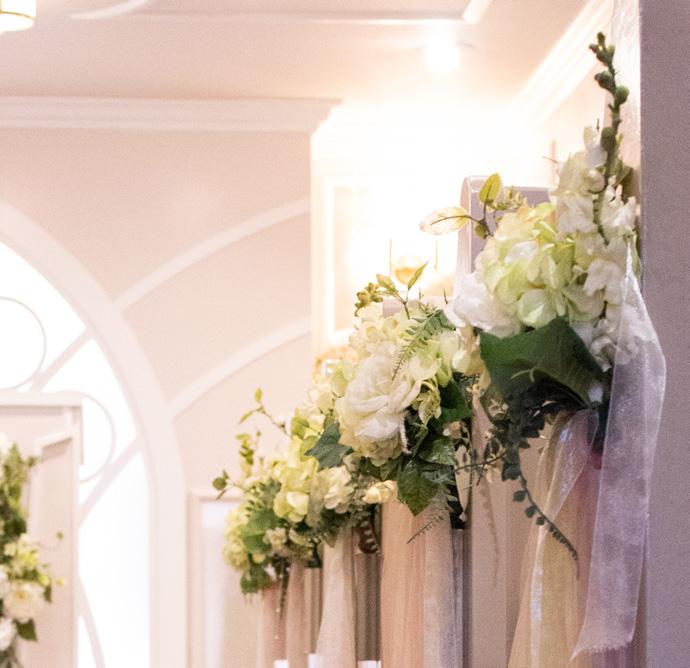
Our two-minute walk is replaced with a drive due to the radiating heat outside; even so, each step exiting the car and entering A Little White Wedding Chapel is oppressive, a sensation so overwhelming I feel like I have melted into my clothes and they have melded into me.
For these herculean efforts, we are rewarded with a miniature white chapel standing at the end of the block like a corner store: grab-and-go marriages galore. It’s complete with a light-up sign, bright green turf, and a cheery white picket fence.
22
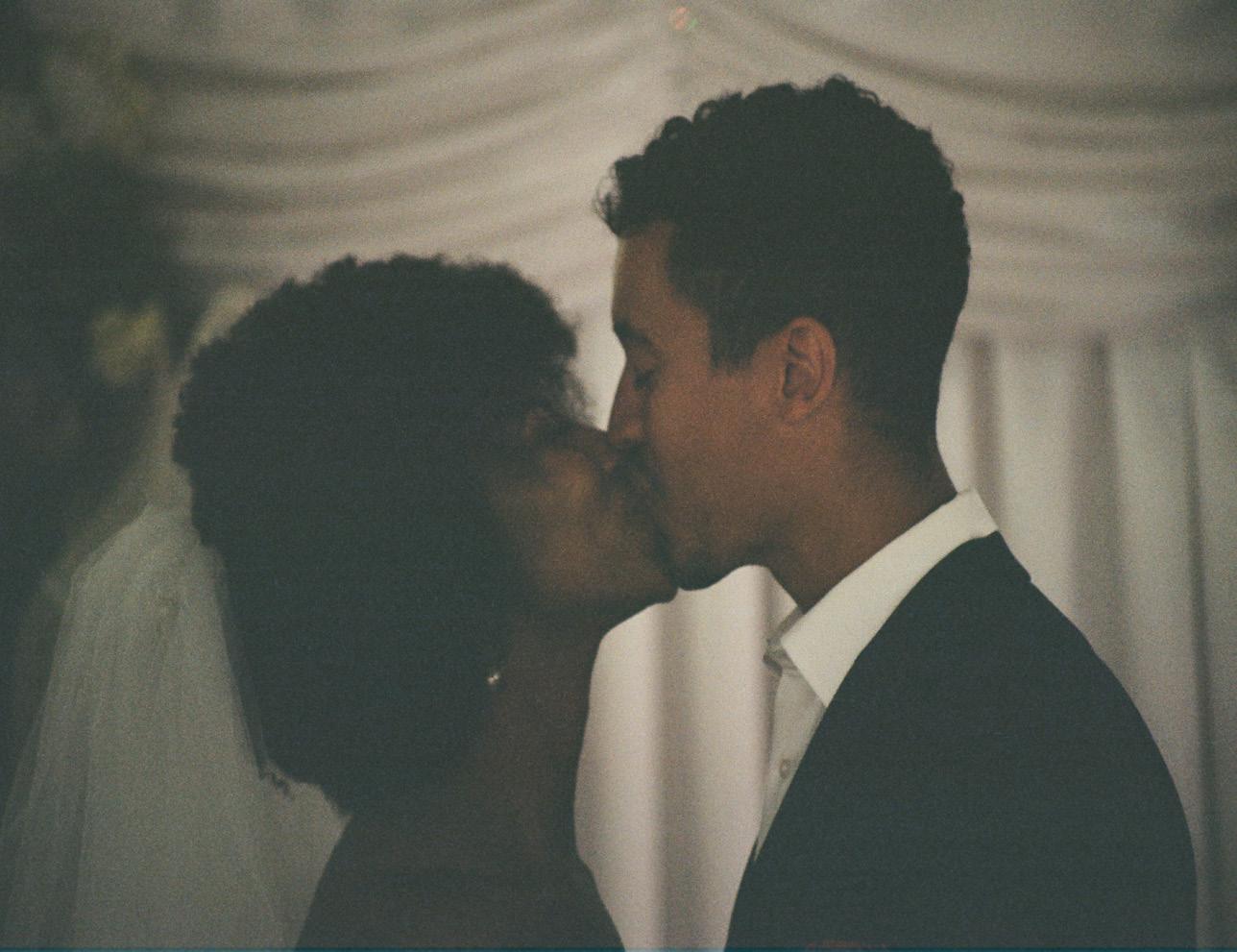

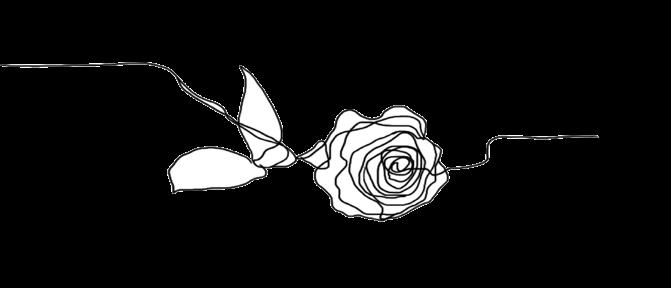

23
Walk in and we are greeted with linoleum floors, the brightest LED lighting, and a line of brides and grooms in the waiting room ready for a signature and ceremony. It’s a strange sight and surreal cognizance that in this small setting, we are witnessing so many strangers experience arguably one of the most important days of their lives. I expect to feel underdressed in a tank top and shorts, but glancing around the room, I am not so out of place.
Within minutes, in Vegas fashion we are invited by complete strangers to attend and photograph my first wedding ever. Past the “Wedding in Progress, Do Not Disturb” sign, we make up the only audience members in the room. The sight before me is cool, white, sterile, but soon-to-be newlyweds Mary and Michael bring life: in a periwinkle mini dress, in a single red rose, in their shared love and laughter, in a greater feeling I cannot begin to put into words.
Marriage is an intended promise and permanence, but when I look hard enough I can almost see the gilded altar crumble and decay to dirt, dust, stone before me. The scene is reminiscent of a photo booth: the altar and Bible mere props, the ruched curtain a facade susceptible to falling at any moment. Is this not performance art? In a city full of performances, perhaps this is the greatest show.

Vegas’ marriage is an ambiguous contract, a delicate balance of coy contradictions. There’s evidence of love here, I think — a mirage in the desert. But first, sell me spontaneity, sell me fleeting freedom. That’s what Vegas is for, isn’t it?
Maybe authenticity lies in the humble, easily attainable wedding Las Vegas presents. Or maybe Vegas, city of lights, city of dreams, has commercialized love. Maybe Vegas is king, pronouncing its ideas of devotion, and I am its jester for entertaining them.
As Mary and Michael tie the knot, I hang onto giant puppy Onyx while we finish photos outside, and he chews straight through his red leash.
How long are you staying in Vegas? I ask. “We leave in a few hours.”
I still find it romantic.
24
THE BERKELEY CONNECTION

words
Catherine Chu photos
Alisa Karesh design
Ira Puri
25
A Ruffled White Veil

Romance at the Palace of Fine Arts
The breeze carries me across the stone path, whisking me along its winding curves. From the corner of my eye, I see a nervous man in a black suit pacing back and forth on the lush, green grass, setting up an eloquent bouquet of roses on a tree stump. He angles it to embrace the looming Palace of Fine Arts in the backdrop. My friends and I hover around the corner, whispering: Oh my god, what did we walk into?
The woman is finally in view, wearing a gorgeous wine red dress and clasping her hands over her mouth in excitement while striding to her man. We all collectively gasp, as the man gets down on one knee and looks up earnestly at the woman, popping the question that random onlookers and family members have all been waiting for in anticipation. She enthusiastically says Yes! and everyone around them claps, us (following suit) as well.
We hear another oohs and aahs a few paces away, and we whip our heads around to see yet another couple seal the deal, the groom offering up a shiny diamond ring for his future brideto-be. Coincidentally enough, there has to be at least six different proposals all happening a couple of meters away from another and within the hour. Even under the grand arch of the palace, there is a wedding in progress, white foldable chairs lined up in neat rows and filled with an assortment of people in their fancy dresses and posh suits.
26
For a couple of college students, witnessing these proposals feels surreal. The couples are in their early 20’s at least, and we are not too far away from thinking about marriage. Pretty soon, we will also be expected to plan our whole life and lay down milestones into adulthood, from the trail of roses leading up to the tree stump to the rows of chairs underneath the looming arch. I anxiously wonder what my own color scheme will look as I take in the amount of floral headpieces. As we walk along the path by the mini lagoon, we shuffle our feet, shaking our heads in disbelief at the sheer amount of proposals and weddings all within the Palace at the same time.

One may call a trail of these weddings and proposals all at the same venue tacky, comparable to getting hitched in Vegas. I roll my eyes, immediately about to snap a remark about how original the couple getting engaged were out of the multiple couples there, until I hear a commotion of cheers. I whip toward the sound, and I see an engaging scene:
A groom and bride, just newly tying the knot, foreheads brushing, smiles sweetly adorning their lips. Just as they are about to whisper endearing words, they are swept away once again into the crowd of their families, mingling among their people, anxious looks painting their faces as they stumble along to the cars for the reception. The bride is tripping over her gown and the wedding party scrambles to figure out car arrangements, cleaning up the chairs underneath the beautiful dome of the Palace. One of the bridesmaids shouts, “You need to touch up your makeup; it’s running!”
I smile in spite of myself. Maybe it’s the college pessimist in me, but seeing a picture perfect wedding has some kind of a rushed and frantic element to it, reminding me that I will always feel a little like my anxious self.

So I step back and admire the situation in front of me: cameras flashing, mothers and aunts tittering, swishes and sways of guests’ satin gowns. I ponder my own future and what level of anxiety I will have when my day comes.
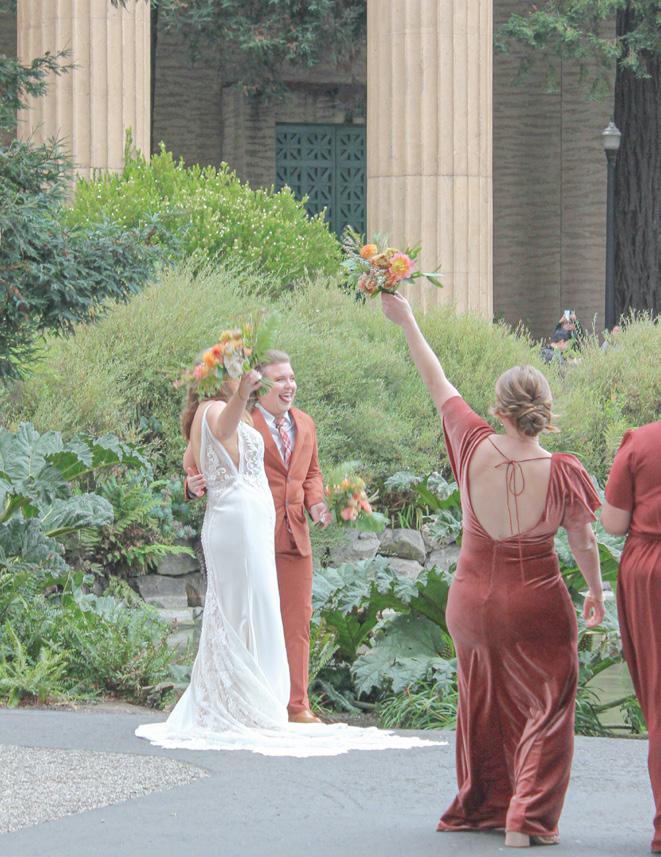
27
The bridal veil is looking a bit crooked now; I like it.
Sex & The (Sin) City
Under the scorching Vegas sun, a secret sexy oasis awaits you
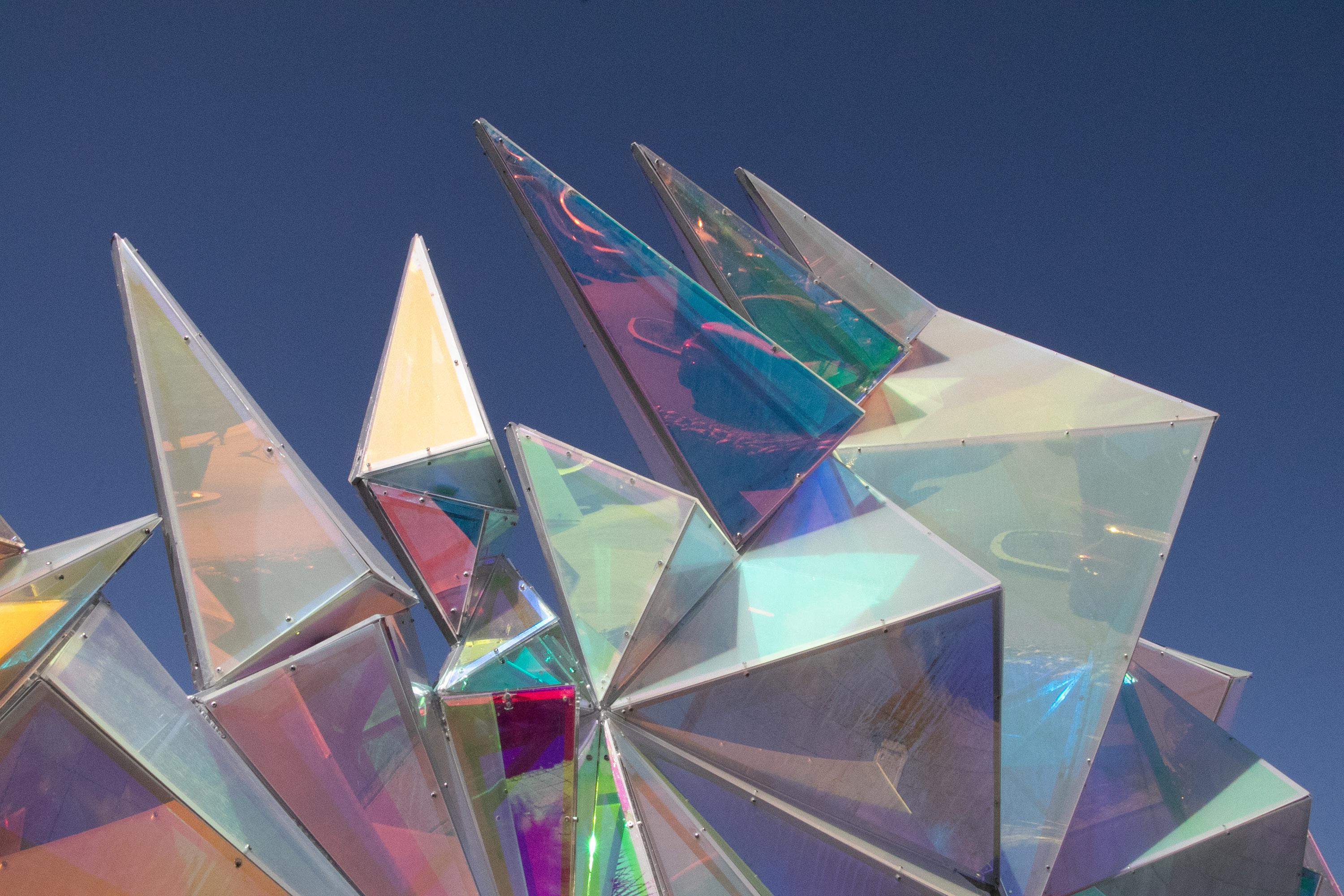
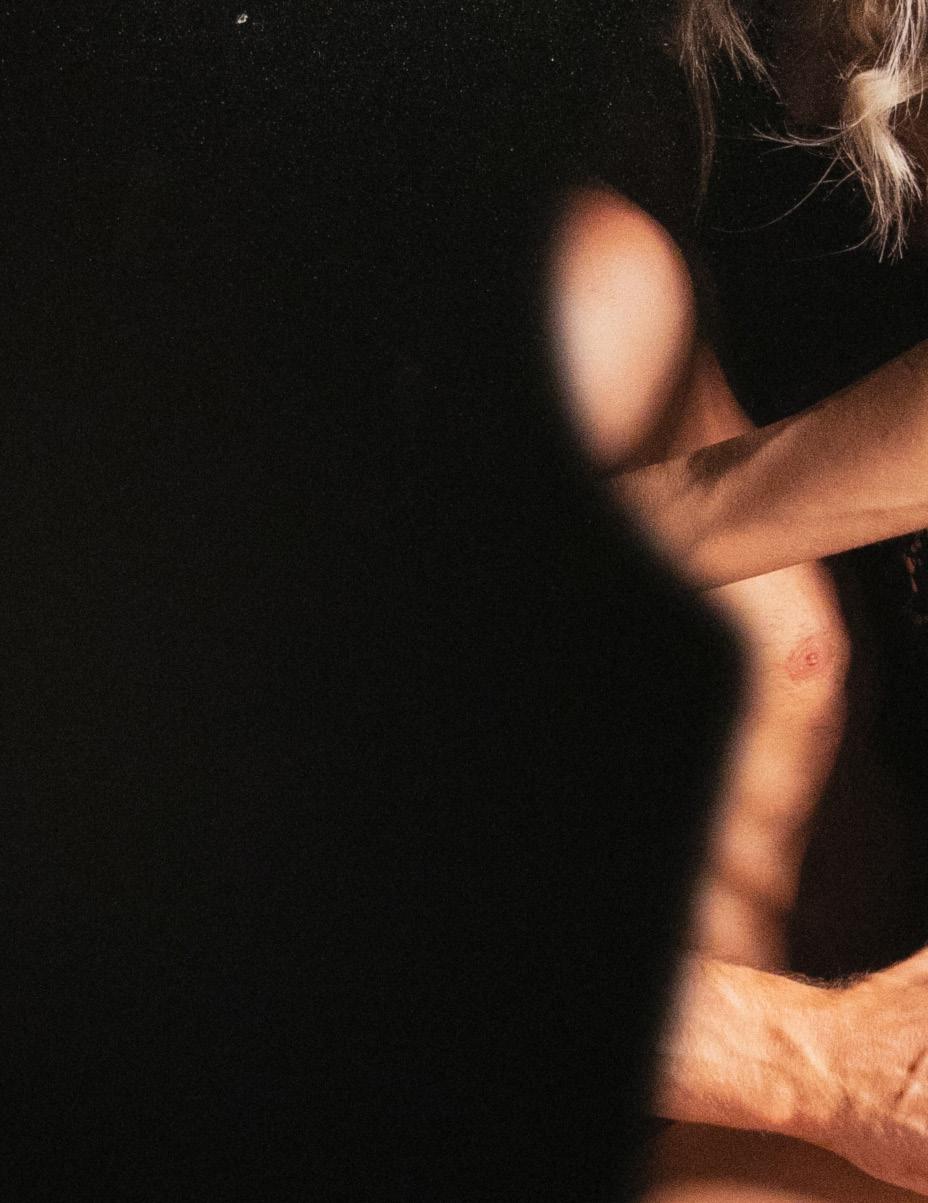
I’m sitting in a dark, circular room. Surrounding me are dozens of screens playing graphic pornography. I count 30, maybe more.
Some of it looks new, like it could have been filmed days ago. Some of it is grainy and in black and white. Some of it has aliens with tentacles for testicles. All of it, combined, is somehow more fascinating than unsettling.
The screen directly in front of me shows a woman wearing a white gown, surrounded by four men. The men are all naked, and the woman has a whip in her hand. I can only imagine what’s about to happen. None of this arouses me, but I’m deeply entertained.
I’ve stumbled upon this treasure trove of erogenous media in Las Vegas’ Erotic Heritage Museum. The museum was founded by Harry Mohney, proprietor of a multinational chain of strip clubs. Dedicated to documenting the history of erotica, the museum today functions as a 24,000 square foot library of the most explicit imagery mankind has to offer.
28
Niko Frost design
Darice Wong
Educational displays

“There is a certain genre of pornography that reads more as a documentary than erotica. Where you learn that some people have figured things out sexually that you had no idea could be done (and, perhaps, would have been fine not knowing.)”
Leaving the woman and her whip to sort out her posse of nudes, I walk into the next room and am startled by an extremely lifelike exhibit of two mannequins engaging in fellatio in a photo booth. Coming around the corner, for a second I thought they were real.
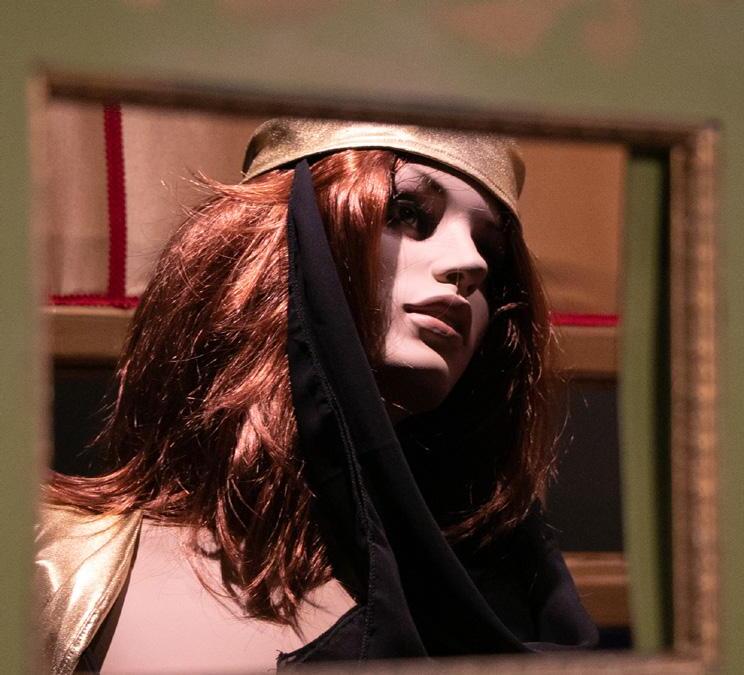

It’s strange to think that twenty four hours prior I was doing ninety through a Mojave desert dust storm, through 112 degree temperatures and pouring rain; witnessing Mother Nature in furious glory throwing literally every weather phenomena possible at us in a span of 30 minutes.
And now I’m watching pornography. With my friends. In a sex museum. In Vegas.
It’s really about as Vegas as it gets, if you think about it. Even more so than the grandeur of the Bellagio and Caesar’s Palace, the fact that some random rich white man decided to dedicate his life to amassing the largest collection of erotic art in the United States really speaks to the absurdity that is Sin City.
Vegas is an experience of extremes. It slaps you in the face before you even arrive, forcing you to drive through one of the hottest and most desolate places
29
on Earth before it springs from the cracked earth like a glowing, neon fungus.
It shouldn’t exist, yet it does. As fungi often do, like the black mold pervading your shower drain even after being sprayed with copious amounts of bleach. No amount of drought, heat, or combination of the two has been able to topple it.
That is really the overwhelming feeling you get when walking through the Erotic Heritage Museum: Wow, this… exists.
It’s really all you can say about it while you’re there. There is a certain genre of pornography that reads more as documentary than erotica. Where you learn that some people have figured things out sexually that you had no idea could be done (and, perhaps, would have been fine not knowing.)
Did I need to know that Catherine the Great employed “foot ticklers” in order to help her get aroused? No, but I don’t know where else I would have learned that. The museum is really a testament to “knowledge is power,” because although I don’t know how much practical use I’ll get out of the things I learned there, I left feeling like I knew something I shouldn’t — like I’d gained a dirty societal secret.

30
Shockingly acrobatic displays of sexual congress aside, perhaps the most surprising aspect of the Erotic Heritage Museum is its politics. Throughout the museum are statements of consent and monuments to LGBTQ+ rights. There are exhibits ranging from an exploration of the trans experience to queer identities in antiquity.
Vegas, while being coined “Sin City,” oddly does not feel like the safest place for a queer person to exist. People come here to escape the societal confines of their hometowns, and sometimes those confines can include masking bigotry and hatred. Mix in the limitless amounts of drugs and alcohol one can find there, and you’ve got a frothing cocktail of people being their most… unfiltered selves.
The museum feels like a refuge from the comparative chaos found on the Strip (maybe because most people who come to Vegas didn’t come for the museums, no matter how sexy). The absurdity of its mere existence drowns out any controversy it could possibly create with its progressive ideas. It knows its audience.
And that, for me, has to be its biggest accolade. This could have been another “Wrigley’s Believe It or Not?” exhibit. They could have shown me a thousand giant dildos and said “Look! This is the most dildos ever collected in one room!” and I would have left both rattled and bemused. I definitely saw a lot of dildos, but more than that, the Museum of Erotic Heritage is a rare beacon of acceptance in a city that capitalizes on just how unacceptable everything it offers is.

A home for sexual deviants (or those who want to learn how to become one), the Erotic Heritage Museum is a must-see for anyone fascinated by human sexuality (and who doesn’t mind watching pornography with a bunch of strangers).

31
Whether at the crack of fiery dawn or the final dregs of dusk — in the cool sanctuary of our cars or the sultry air of the Strip — music seemed to permeate our every waking moment in Las Vegas. It kept our spirits high as we journeyed between diverse crowds, contrasting climates, and stunning spaces both built and natural. Through everything, we sang, danced, played, and explored. Here are the tunes that encapsulate Caravan’s wild weekend in this eccentric desert city.
XS / Rina Sawayama / SAWAYAMA
Die For You / The Weeknd / Starboy
parking lot view / almost monday
Timber (feat. Ke$ha) / Pitbull, Ke$ha / Global Warming: Meltdown (Deluxe Version)
Liability / Drake / Honestly, Nevermind
Vegas / Doja Cat
Où va le monde / La Femme / Mystère
Night Changes / One Direction / FOUR (Deluxe)
Pursuit of Happiness / Kid Cudi, MGMT, Ratatat / Man On The Moon: The End of Day

Toxic / Britney Spears / In The Zone
Lights Up / Harry Styles / Fine Line
Into You / Ariana Grande / Dangerous Woman
Adventure of a Lifetime / Coldplay / A Head Full of Dreams
LAS VEGAS PLAYLIST 01 02 03 04 05 06 07 08 09 10 11 12 13 32
Timeless Treasures
Reminiscing in the Antique Alley Mall
Tucked within a side street of the Arts District in Las Vegas sits the Antique Alley Mall, its interior a unique juxtaposition with the exhibits in the surrounding area. Nearby galleries rotate in new art periodically to keep exhibits enthralling for visitors because old things become uninteresting, ordinary, mundane. We travel to see new places, taste new foods, engage in new experiences.
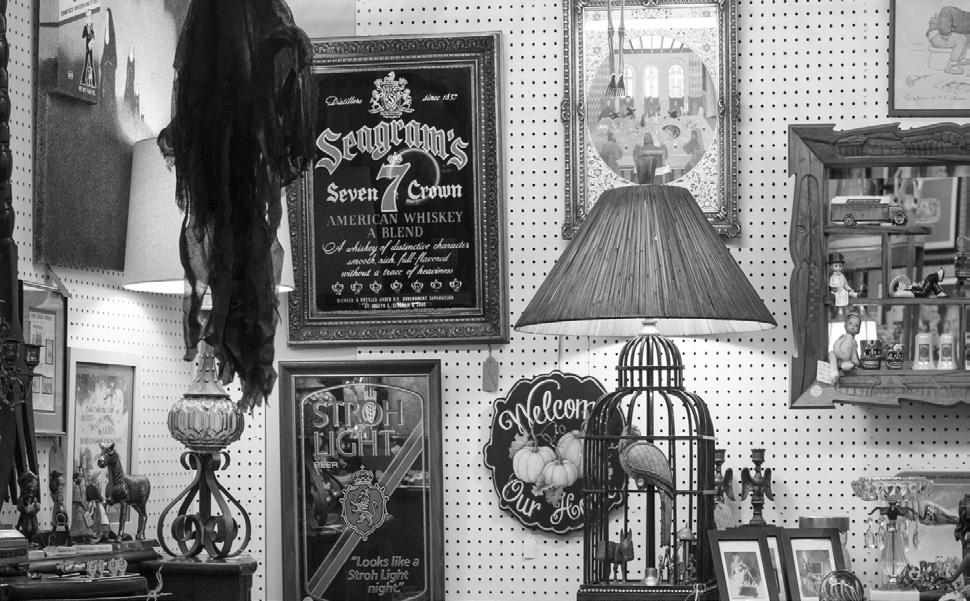
And yet, as much I love adventure and novelty, I must admit that I am an incredibly sentimental person. I have a box tucked in the corner of my closet filled with cards, notes, and school projects from elementary school. Shoved within a drawer sits a crocheted giraffe, origami creations, and handwritten notes from my ex that I no longer want to see but am simultaneously reluctant to discard.
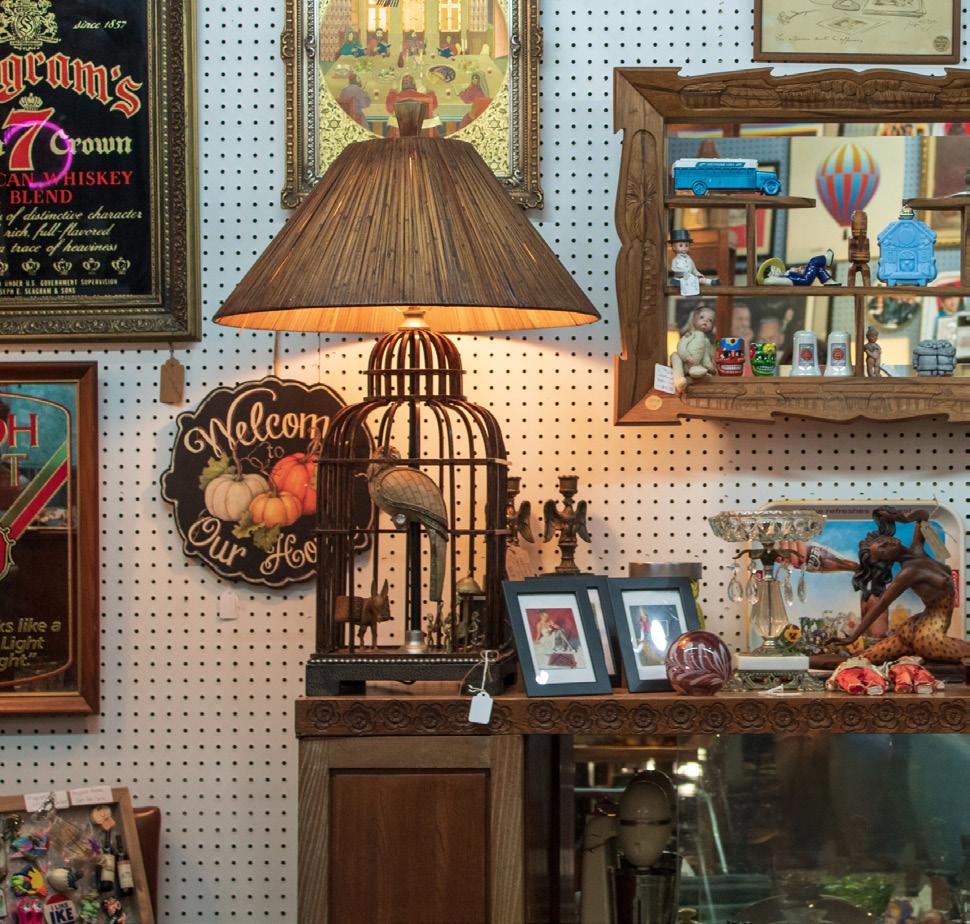 words Nicole Ru photos Christina Kan Emily Langton William Fei design Christina Kan
words Nicole Ru photos Christina Kan Emily Langton William Fei design Christina Kan
33
They are more than a painful reminder of what used to be; they represent the warm memories I have of a relationship that formerly brought me comfort.
Despite the unassuming storefront, the interior holds eccentric machines and car seats that seem more appropriate for a neighboring art gallery than a simple antique shop. When we first enter, a conglomeration of knickknacks scattered across tables, shelves, and walls greets us. Upon closer inspection, there is some order to the chaos — collections of cards, cars, and cartoon figurines rest on neat shelves, while larger sculptures and disassembled parts lay around the room in a deliberate arrangement. This leaves just enough room for people to squeeze past each other amongst the tables filled with miscellaneous postcards, jewelry, and decorative pieces.
Hidden behind the two open rooms at the front sits individual sections of more vintage items. I take my time meandering around, simply taking in the different trinkets offered by each corner. The little booths set up around this area catch my eye — it almost seems like separate vendors renting out their own spaces in an antique market.
During my second (or third? I’ve lost track) lap around the store, I manage to catch Jennifer, one of the vendors, who agrees to chat with me. I learn that the individual booths aren’t just a design choice; they’re owned by separate vendors who curate personalized collections of antique items to sell. Some vendors, like Jennifer, primarily sell old family items. Others, like George, the owner of the shop, will go out to flea markets and garage sales to seek out items they can resell.
During our conversation, she mentions that many of the items she sells hold little meaning, but you never know what will appeal to a customer walking by. Some regulars will swing by every few weeks to see if something new might catch their eye for unfathomable reasons.
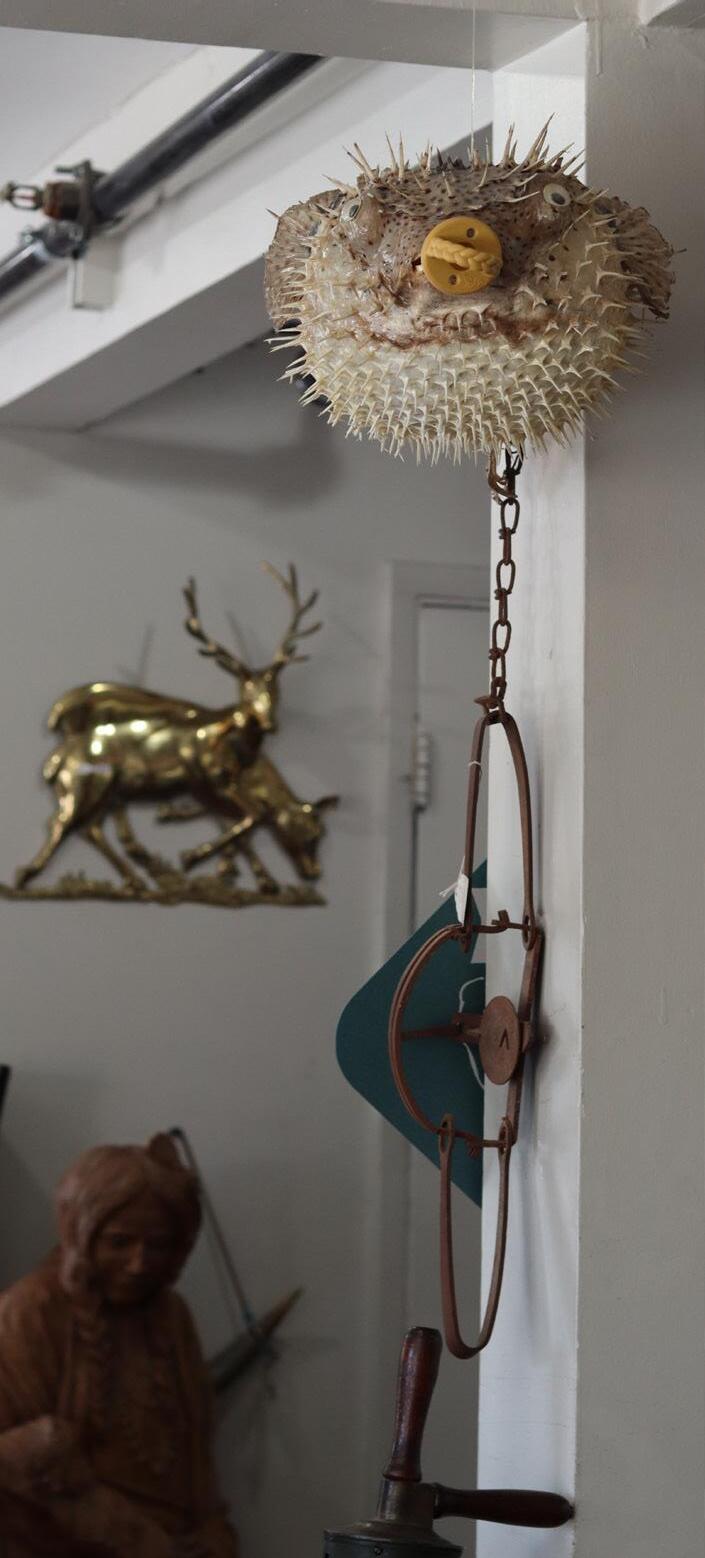
As someone who tends to hold on to things for longer than they’re truly useful, her words give me pause — the utility of an item differs from the value and meaning it offers.
Most people would probably agree that the majority of things filling this antique mall hold little utility. Decorative license plates and miniature cars from the 80s serve no practical purpose, but that doesn’t mean they are meaningless.
34

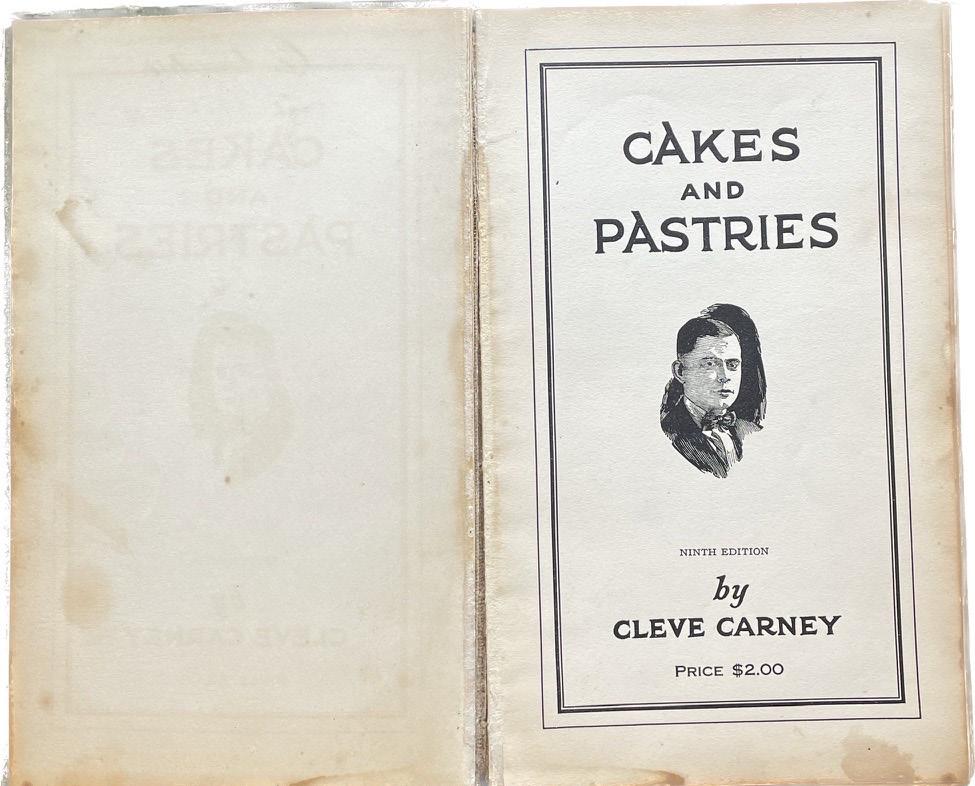
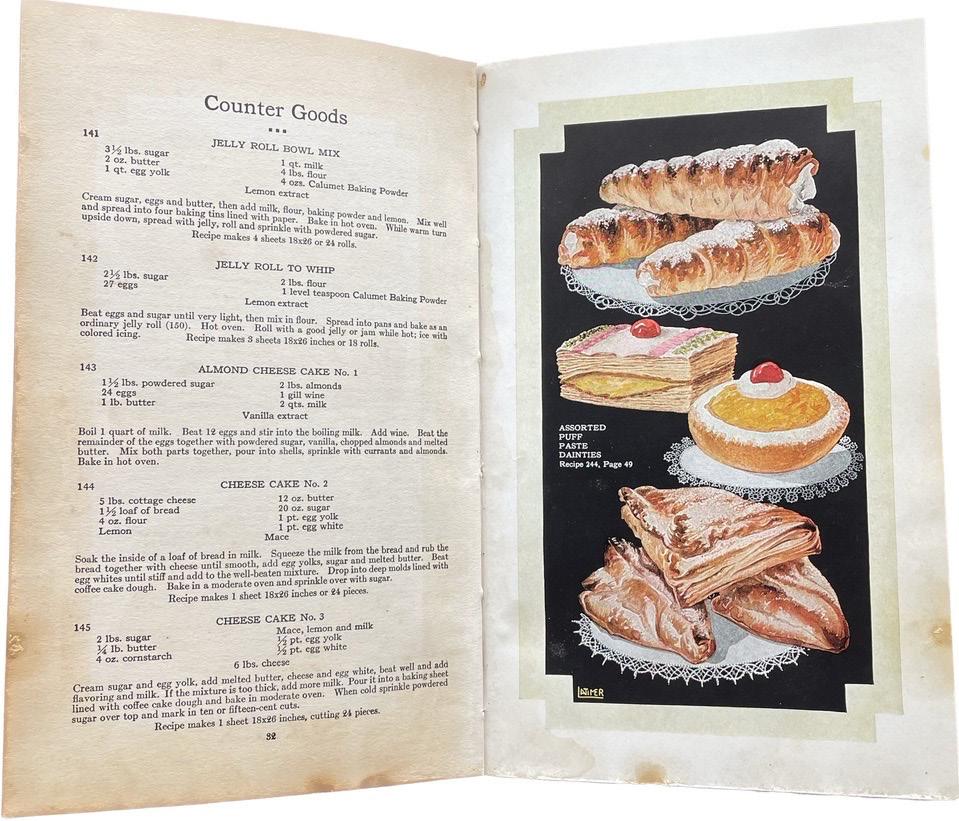
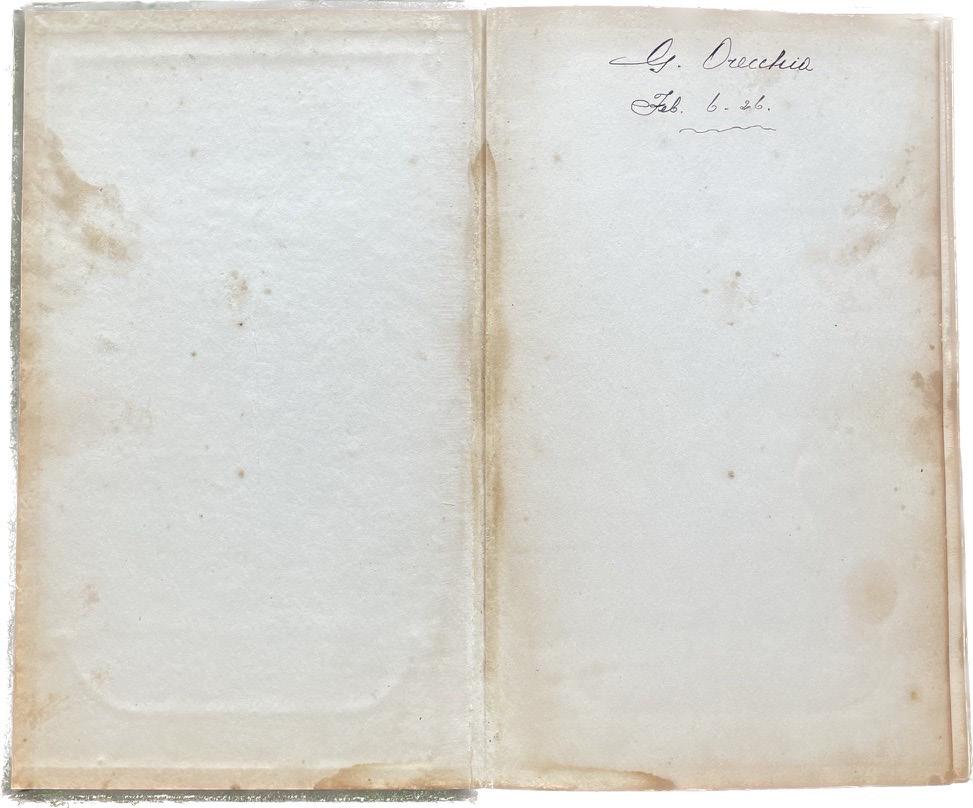

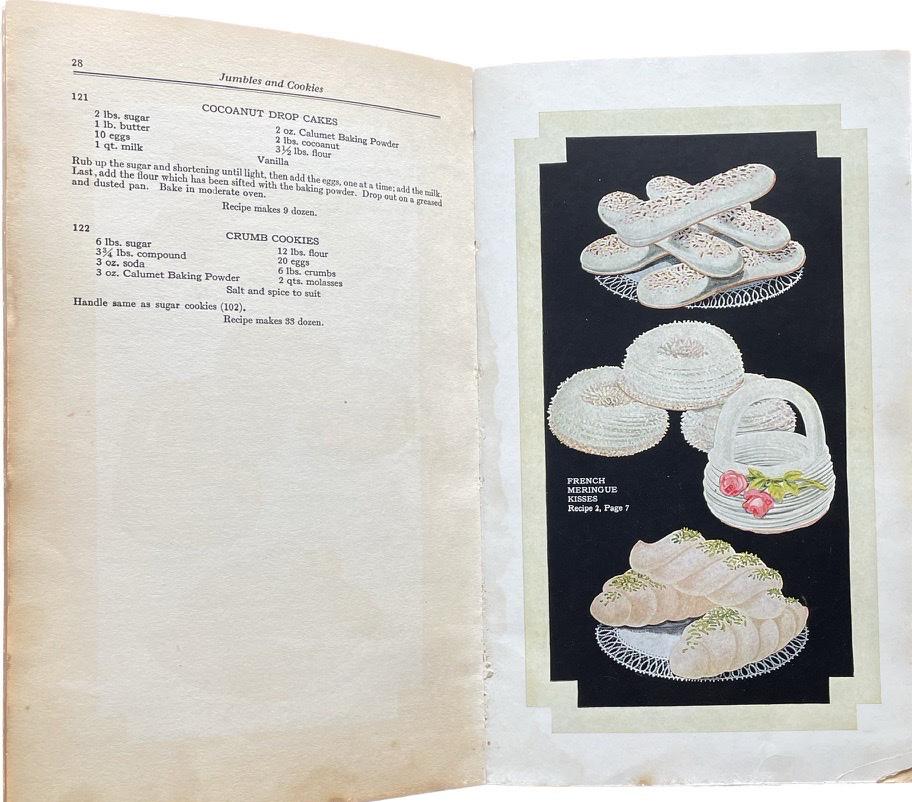
35
Jennifer points out a pair of earrings that hold sentimental value for her; they belonged to her grandmother, and Jennifer also wore them before deciding to sell them. They have been sitting here for a long time. On the other hand, a keychain that she has no clear recollection of caught the attention of a customer less than a day after being set out. Certain items spark conversations with people who find a personal connection with something that reminds them of a loved one.
I make a final loop around the shop, carefully selecting some postcards for myself, and after wandering for just a little longer than necessary (I’m surprised to see how much time I’ve spent here without realizing it), I pick up Jennifer’s book of recipes for my friend who loves baking.
For the vendors at the Antique Alley Mall, vintage and antique items are more than a peculiar interest; they serve as their livelihood. However, these items also serve to bring people together. Reminiscing and coming to terms with the past allows us to connect with people in the present and look forward to the future.
Las Vegas is an extraordinary city, one filled with extraordinary attractions. The Antique Alley Mall is an ordinary store filled with ordinary items.

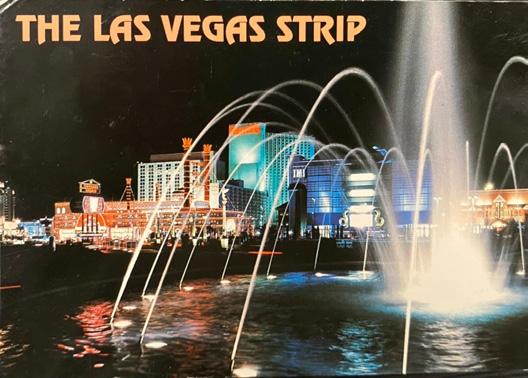

And yet, the Antique Alley Mall is less of a juxtaposition with the city where it dwells than one might assume. It serves as a resting place for weary travelers, a connection between the past, present, and future — much like Las Vegas with the timeless feeling of a city that never sleeps.

George has always had an interest in antique and vintage items, and the Antique Alley Mall allows him to share this passion with other vendors and customers. His business offers an appeal ing deal for vendors renting out space; they don’t have to be in the store every day to sell their items, which gives them the flexibility to spend time on other endeavors.
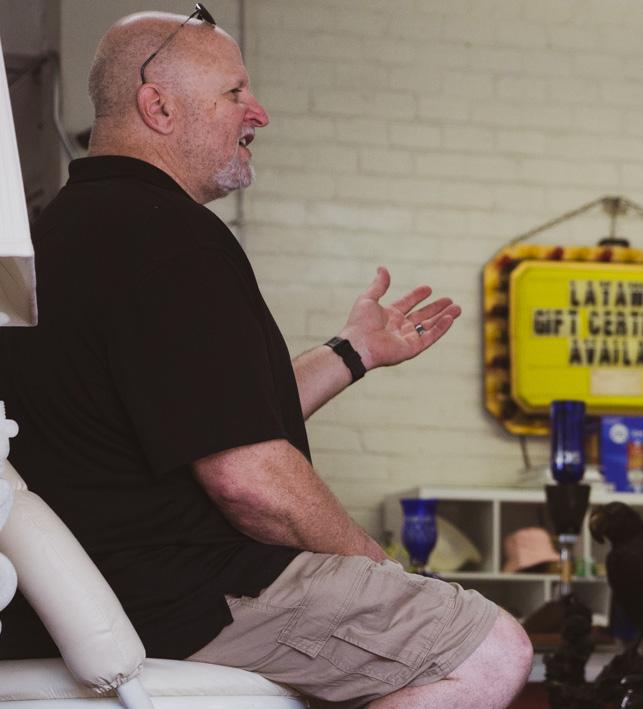
left postcards left page cookbook pages
George Lovitt, owner of Antique Alley Mall
36
A Grand Garage Sale Hunt
The artistic productions within San Francisco garages, kitchens, and driveways
It’s a Sunday afternoon in San Francisco. The sterling fog is consoling, much like the solace of rain in my hometown — Seattle, Washington — where it rains more days than not. Today, the fog muffles my surrounding world in comforting layers.
We’re about to go garage sale hunting, an activity that my mom and I loved when I was a kid. I sense a piece of home in our upcoming scavenger hunt. The feeling, not the place.

Our first stop is in Potrero Hill, a residential neighborhood just across
the Bay Bridge known for its view of the bay and surrounding skyline. After an impromptu photoshoot, our group put together our foggy minds to locate our first garage sale of the day. We ask local neighbors, decipher potential fellow garage-sale-hunters, and scrupulously deconstruct the vague Craigslist description. And before we know it, we are welcomed into a warm and visibly loved home on Mississippi Street.
It’s a funny thing, being welcomed into a stranger’s home. I feel the need to tip-toe across the floor. You don’t live here. You’re a guest. Proceed
THE BERKELEY CONNECTION
words
photos
Robin Ying
Anette Brecko design
37
Haniqa Rahardjo
with caution. Always ask for permission. Frequently say thank you. It’s like my mom holds my hand, whispering in my ear as we walk through the house.
I soon relax into the home’s calming embrace. There’s a lively assortment of items in front of me: shot glasses, a compass, lace doilies, a tote bag, old cameras, a birthday card. These scattered belongings tell a narrative of a home that has lived a life of its own.

The living room table’s finish has eroded away — someone hasn’t been using a coaster. The kitchen’s beige wallpaper is peeling at the sides — who’s been using the stove without turning on the fan? Every few steps, the floorboards squeak a bit — how many families have lived here?
The hosts are delighted we’re here. Relieved, even. They’ve lived in their San Francisco home for their entire lives and are eager to move, preferably with much less stuff.
“We’re moving to Southern California to be closer to our family,” the mother says.
I ask — among other options (like donating), “Why a garage sale?” “I used to love going to garage sales with my mom,” she says.
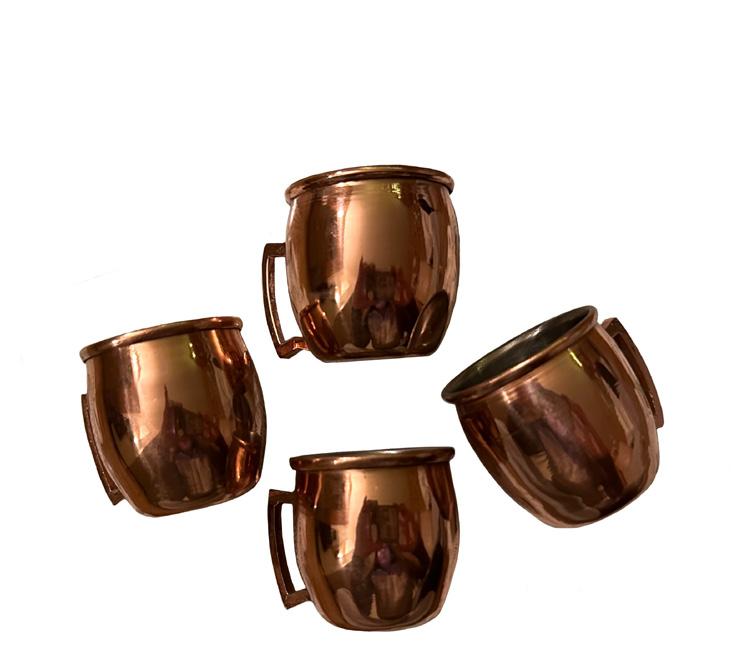

I interject, “Me too!”
We connect through the joys of garage-sale-ing with our moms. It’s not about buying things. It’s about leaving a sacred space with gems in your pocket, items that mother and daughter uncover together. My mom and I would find the craziest things — dolls missing their limbs, glassware from centuries ago, sequin-adorned clothing that we really wanted to buy but never did. These sales bred snarky inside jokes, collective laughs, and the occasional tearful telling of a funny story.
We leave the Potrero Hill home, most of us with tote bags and trinkets of little utilitarian value. Along with a golden compass, a birthday card that I picked up for my mom now lives at the bottom of my bag.
Our next stop is a 5 minute drive away in the hipster Mission District. As we drive through, I proclaim to our car, it’s an “EVERYTHING MUST GO” type of sale, according to the Craigslist description.
38
a. gold sequin handbag
c. set of four mugs
b. flame-shaped sunglasses
A nostalgic, heartwarming scene approaches our field of vision as we drive up. Kids run around, screaming, fighting, playing hide and seek — all in good fun. Parents from the neighborhood chat over hobbies and homes. Before we even step out of the car, a large “Welcome!” is exclaimed by a few children smiling back at us.
We walk by tables with clothing spanning the past three decades, dig through boxes of a fashionista’s old shoes, and run our fingers through miscellaneous fabrics and scarves. There’s everything and nothing here. I don’t particularly want to purchase anything, but I have this unspeakable urge to consume, to pick things up, to search for something meaningful.
I leave with something I absolutely don’t need, a gold sequin handbag that my mom would’ve never let me buy. I can almost hear her mutter, “Oh, God. Don’t buy that,” as I giddily hand over three dollar bills to the host.

We gear up to leave the garage sale and thank the hosts, and I realize that in our time as visitors, we’ve become guests of a neighborhood block party. Between the adults chatting about their homes & hobbies and the children playing hide-and-seek, I can’t help but gravitate towards the exhilarating hideand-seek game.
Our next stop is in Midtown Terrace, a neighborhood nestled in the abundant greenery of the San Francisco hills. It’s a dense but charming neighborhood with beautiful views of the city, the Bay, and the Pacific Ocean.
After two garage sales, you could say we’ve approached garage-sale-expert territory. We’re prepared. But what we drive up to is not your average garage sale at all, it’s a party.
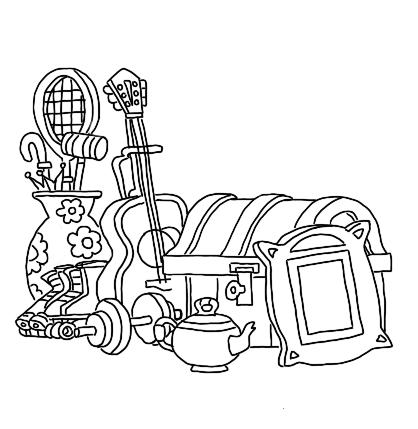
39
Upbeat music echoes throughout the driveway. Bowls of popcorn are scattered around the display tables. We’re standing in a beautiful rainbow palette of handmade pieces of jewelry, abstract DIYs (purses made from basketballs, plant pots made of cowboy boots, etc.), and my personal favorite — a box of t-shirts and sweatshirts for which the host will tell you, “You can have that for free; it was my ex-boyfriend’s.”
Though perhaps the best part was the “Free tequila shot with each purchase!” — not only for the customer but the hosts, too. That’s what makes this a celebration.
Garage sales aren’t economical. I mean, you might make a couple hundred dollars, give or take, depending on what you’re selling — but no one really does it for the money. The free tequila shot was proof.
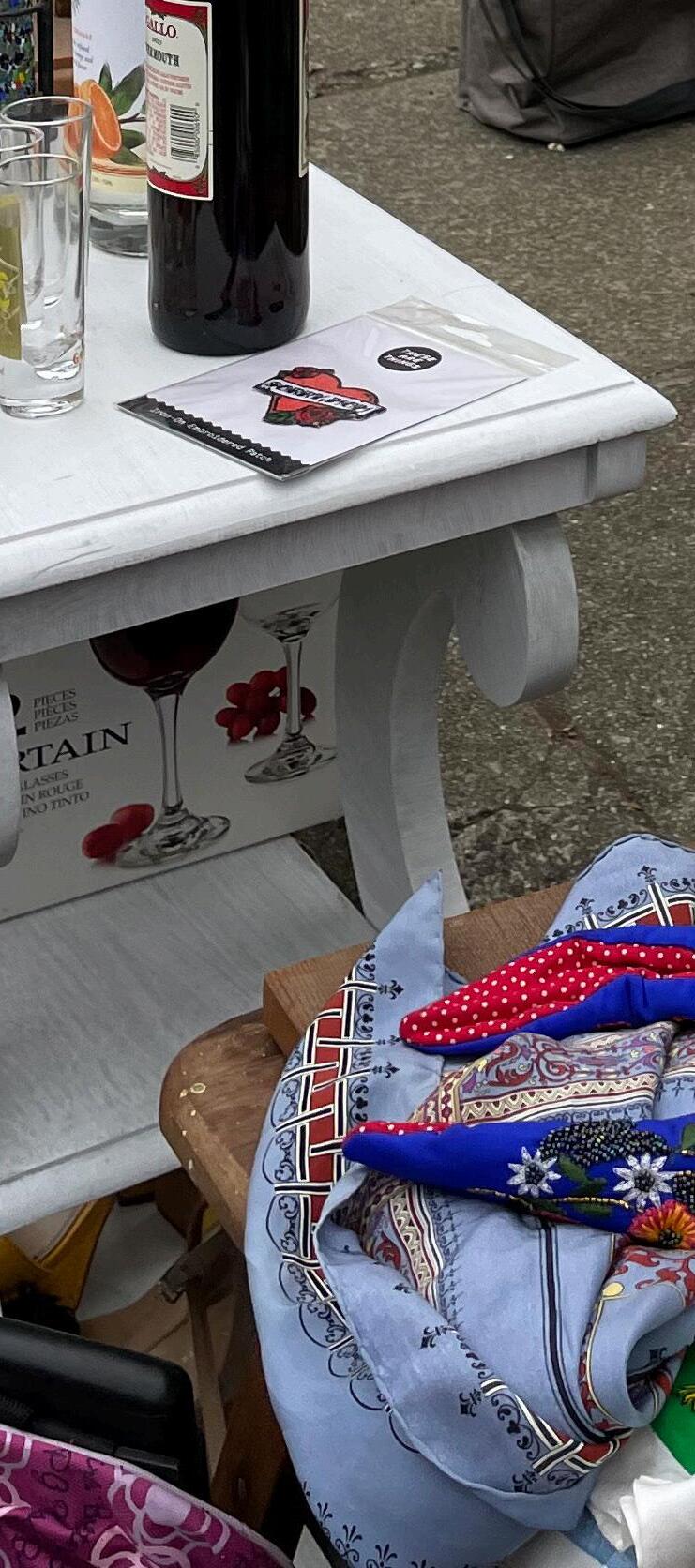
In preparation for this article, I actually read a couple of anti-garage-sale pieces. And let me tell you, these authors were no fun. Sell your precious items at a pawn shop. List your used clothing online. Donate everything for a tax deduction.


But here’s what anti-garage-sale propaganda fails to mention: everything about these sales is an art to be mastered. Gathering a group to travel through a San Francisco scavenger hunt beats any trip to the pawn shop. Hosting a block party that will form core memories for your children far outweighs any potential tax deduction. The free-tequila-joy on a customer’s face spurs much more joy than some Facebook marketplace listing ever could.
During our garage-sale-ing days, my mom and I weren’t just shopping. We were contributing to something greater — playing characters in an artistic, experiential production. This cherished art brings me home, perhaps even more so than Seattle’s muffling layers of rain.
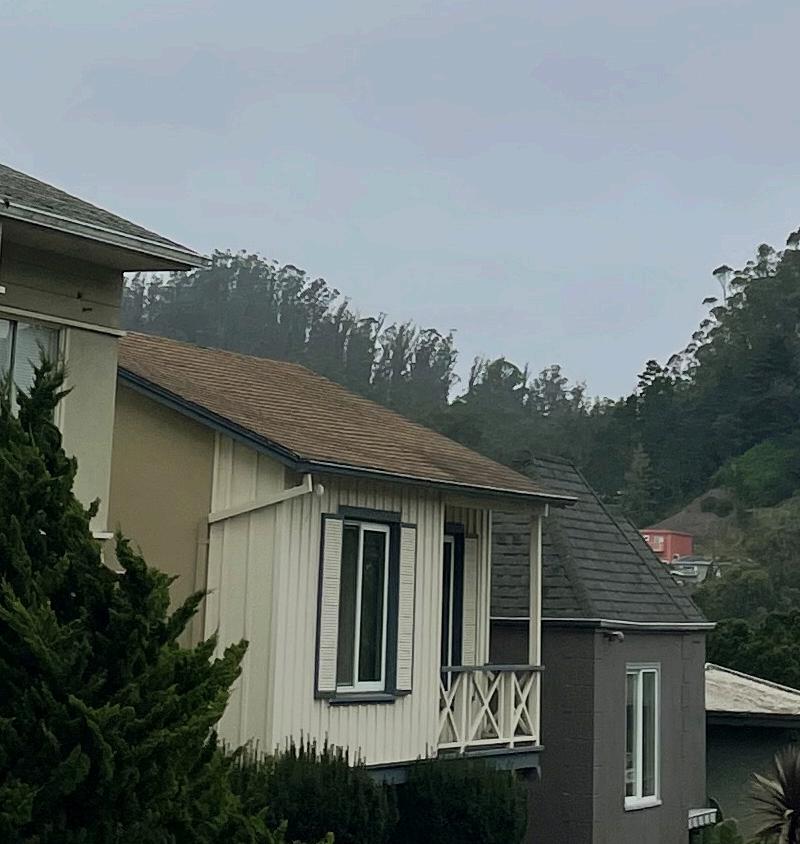
40
The Last Of Us
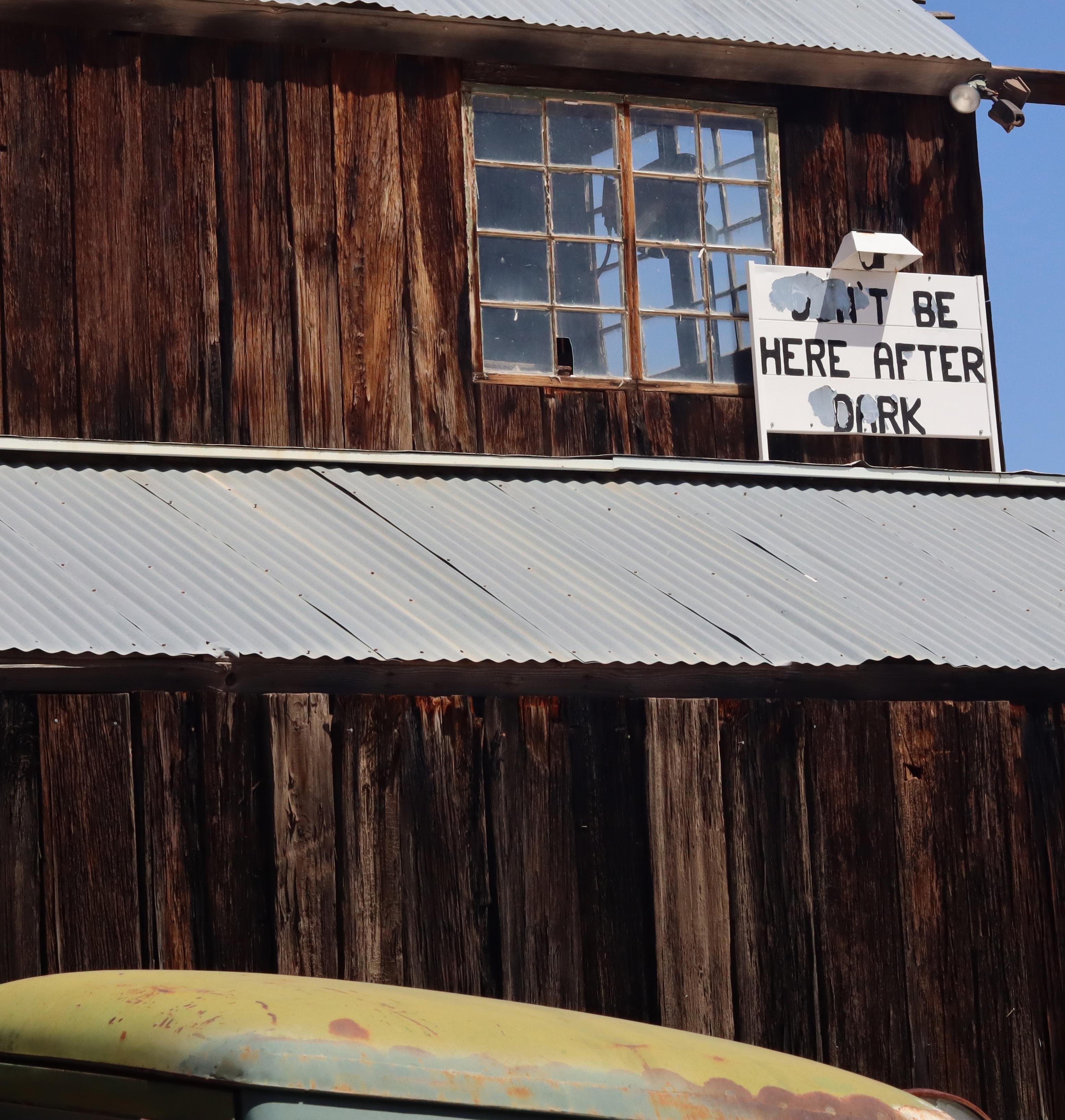 photos
Christina Kan
design
Christina Kan
PHOTO SPREAD
photos
Christina Kan
design
Christina Kan
PHOTO SPREAD
41
Scenes from the Nelson Ghost Town
We drive down a desert path to seek out the small ghost town of Nelson. Nestled in Eldorado Canyon, this family-owned site is just over four square miles in size. It comprises a colorful junkyard, weathered buildings, faded machinery. And a scattered amount of retro Coca-Cola signs.

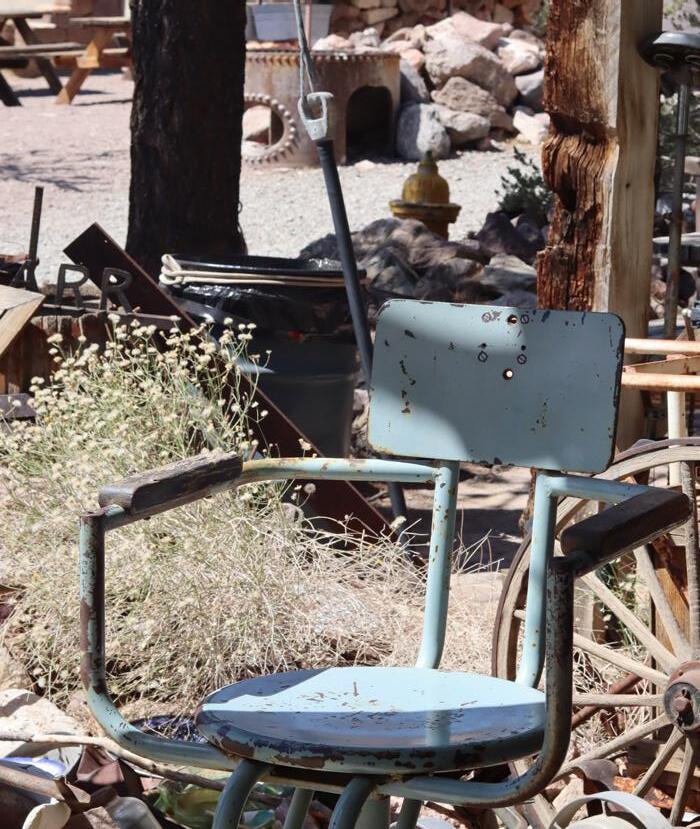


A pink billboard welcomes us with a handful of rules to keep in mind.
1. Everyone must now check in at the store First.
3. Due to the abundancy of Stupid People, you can no longer just walk around here.
5. PARENTS - Stray children and teenagers will be shot on site.
7. If we are closed or after dark DON’T STOP… GO AWAY.
We roam the rest of the town in caution.
42

43

44


45
words
Darice Wong
It’s impossible not to be astonished by the landmarks that distinguish this part of town: an extravagant gateway, golden statues, elaborate hip-and-gable rooftops. But perhaps I’d be less surprised by the sight of these cultural objects if it weren’t for their unexpected surroundings — a plaza structured like an outdoor megamall rather than the historic Chinatown neighborhoods it shares a name with.
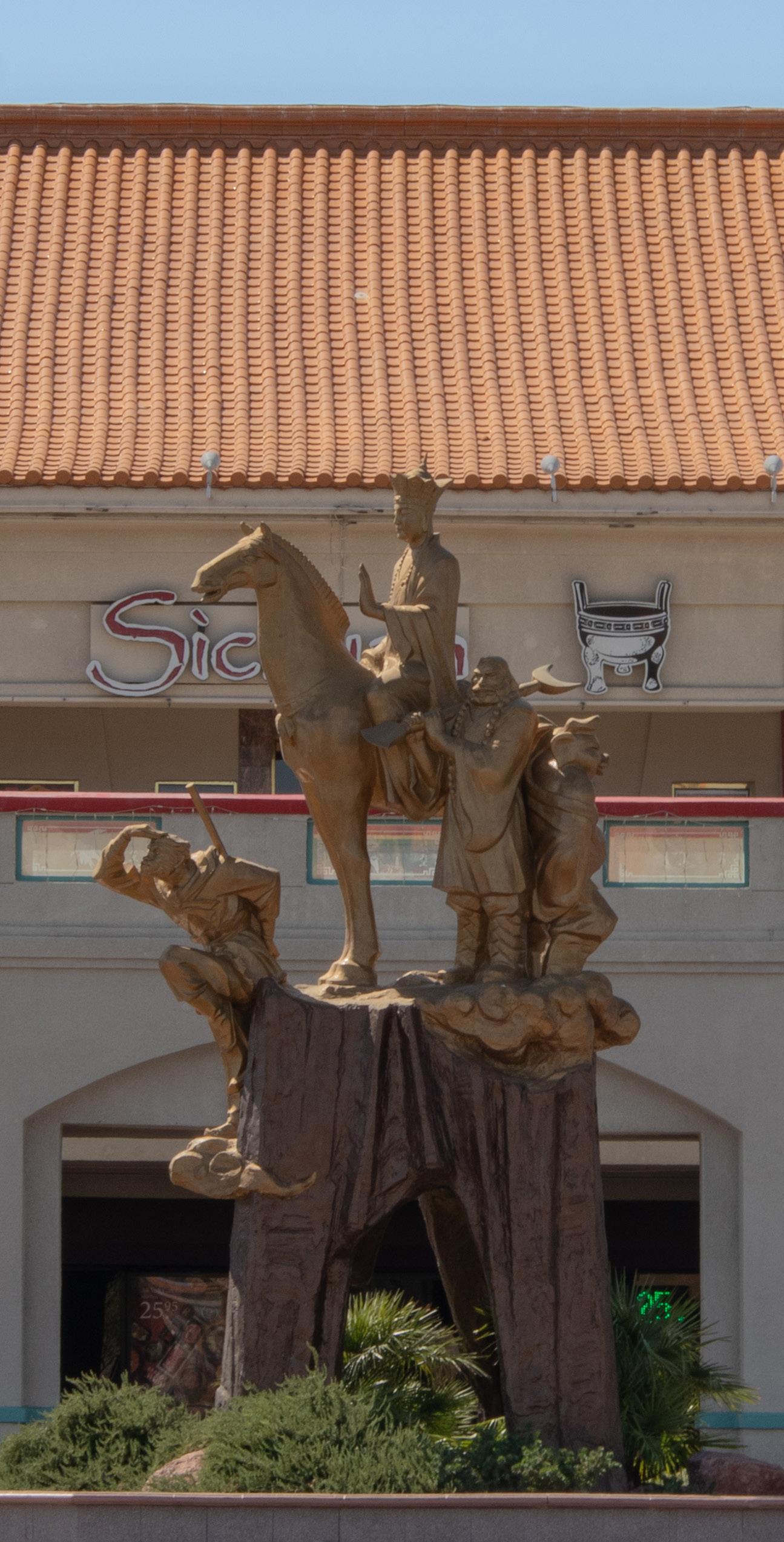
Making Space
Community at Vegas’
“master-planned” Chinatown
Aesthetically, the Las Vegas Chinatown parallels many other designated Chinatowns in America, blending urban architecture with ethnic embellishments that visibly declare the place’s function as a hub for Chinese culture. Unlike the others, however, this Chinatown is no town at all. Upon arriving, we discover a sprawling district consisting solely of over twenty different shopping complexes. There are no homes to be found here, only boundless acres of stores and parking spaces.
46 NON-EDITOR
photos James Nguyen Niko Frost design Ira Puri
CONTRIBUTIONS
What little history I know of the area explains its total commercialization. The Vegas Chinatown didn’t start out as an immigrant settlement as most Chinatowns do, and at the time of its establishment, the local Chinese population wasn’t large enough to drive such a major development. Instead, the entire district was a business endeavor conceived by Taiwanese-American entrepreneur James Chen in 1995, who called his project “America’s first master-planned Chinatown.”

Standing here, I’m unsure of what this attempt to recreate a Chinatown has meant for Chinese culture in Vegas. Artificial origins or not, the impressive scale of this operation and the grandeur of its cultural monuments cannot be denied; even in this punishing heat, we linger outside just to capture photographs of the plaza’s traditional Chinese paifang, our bodies dwarfed by the enormous gateway. Plus, there’s no shortage of wares and cuisines to pick from here. It’s almost lunchtime, and sure enough, a few families have started to arrive, presumably headed to the indoor mall for a meal. The scene makes me curious to know how the offerings inside might compare to their shiny exterior.
We then make our way to the mall. Although the building is slightly rundown, we aren’t any less entertained by what we find. Children run around playing tag in the halls, where their mothers also
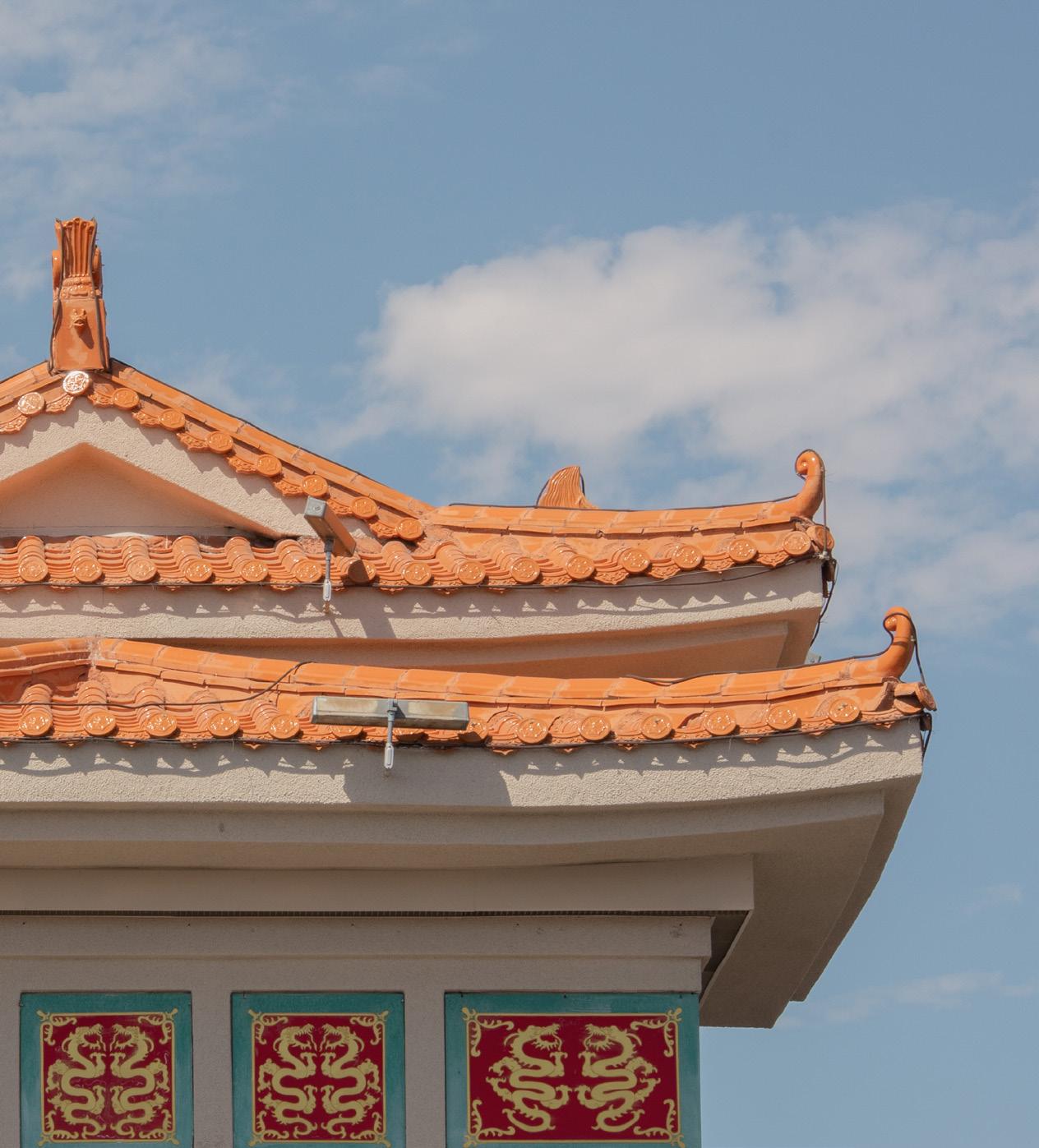
47
sell jewelry and make small talk. One elderly man near the entrance invites us to peruse his assortment of glittering Buddha statues and Asian ceramics. Nearby, a woman attends to boxes of myriad herbs and medicines, oblivious to our curious stares. And in another store, we brush shoulders with fellow customers between a narrow maze of shelves, well-stocked with trendy Asian pop culture merchandise. There’s evidently a broad mix of people who are served by this district. While it might include tourists seeking a taste of something vaguely foreign, it also includes those simply searching for a taste of their own culture.
These audiences aren’t too far off from ones you would find in Chinatowns elsewhere. After all, the distillation of culture into its most widely palatable commodities — certain foods, decorations, popular merchandise — is a practice equally embedded in the nation’s very first Chinatowns of San Francisco or New York, born out of the need to sell and survive in the face of discrimination and de facto segregation.

Yet I realize now what’s been troubling me since I arrived. The fact that this Chinatown doesn’t share quite the same history makes its deliberate adoption of the label, along with its associated aesthetics, something to be examined. Particularly in places originally devoid of geographic enclaving, who is being served by this insistence on corralling Chinese or Asian businesses into separate, exotified districts?

48
Perhaps part of the answer is the city itself. Vegas works hard to take you anywhere but here, to replicate something and sell you the spectacle of it; the city’s glittering Chinatown, which profits from maintaining a fantastical veneer of rich heritage, has been unable to escape this same tendency.

Even so, co-existing with this reality is the fact that I’m here, that people who look like me are here today. Despite issues surrounding the implications of its history and design, the Las Vegas Chinatown has been an integral pocket of culture and food for the Asian community of Nevada, which is now ninefold what it was when the Chinatown was first established. We have always needed spaces like this, and we have often carved them out for ourselves. Under what appearances, conditions, or labels, though — that’s something that can and should continue to be negotiated. There’s an opportunity, here, to reconcile what this place has been with what else it could someday be.
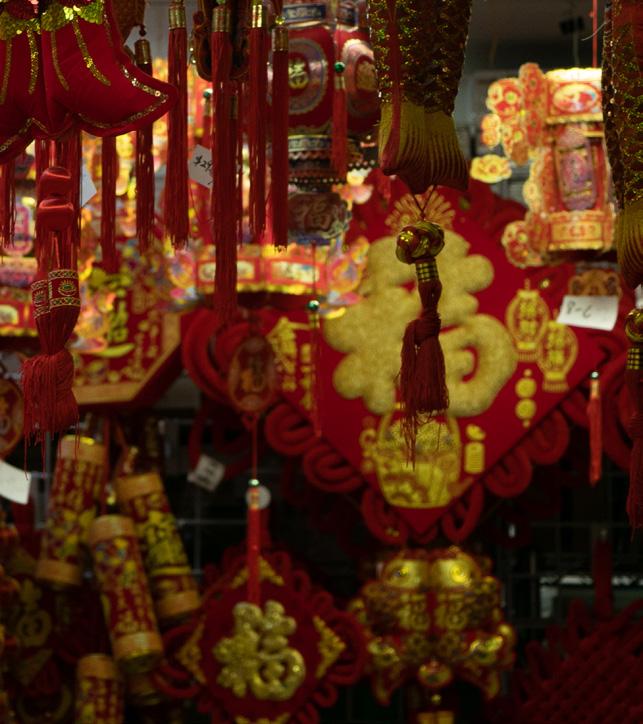
It’s time for us to leave. At the bakery near the exit, Niko buys a pineapple bun for the road. The rest of us decide to depart without sustenance; still, we take a few minutes to gush over the displays, coveting the nostalgic flavors behind the glass. It’s this moment that reminds me, vividly, of other Chinatowns that I’ve visited in the past. It’s like if I turn around now, I’ll see my father, a box of golden tarts in his arms, his head bent in conversation with a storekeeper in some city miles from where we stand now. If I turn around now, I might see myself, still searching for meaning in these spaces we inhabit.
The contradictions of this place, and this city, weigh on me. I let them. I hold them close, imagining what else they might one day become.

above Decorations for sale 49
Sasha Shahinfar photos
Apollonia Cuneo design
Sakeena Baxamusa
Troubling Stickiness
A study of spaces and bodies stuck in Vegas
It’s 112 degrees. I feel the beads of perspiration collecting on my brow bone and sliding down my temples. The heat licks up every drop of moisture, the sweat evaporating before it could collect and drop off my chin. I taste my own salt. Is a sticky sheen part of the traditional Las Vegas garb, induced either by beginners’ betting anxiety, an alarming number of chain-smoked cigarettes, or in this case the boring culprit – relentless, sweltering heat? Caravan rolls into Vegas in small, AC-less rental cars, all our members united by the same sticky, miserable wetness.
Our travels begin far removed from sheltered shopping malls, giant slushies, and all manicured Vegas infrastructure designed to keep the sweltering heat at bay: at the Valley of Fire State Park.
Swiftly, we park and shield ourselves with sunnies and baby-brimmed hats. It feels impossible to traverse the aptly named Valley of Fire as the heat beats down on our necks.
Standing under the merciless sun, sweating bullets, we excavate, unearthing Vegas. The sedimented past comes into focus, that is, the bones upon which the flesh of Sin City was laid.
The Before: naked desert.
Like undressing Vegas, in the desert we conceive of it without the decorative layers of simulacra.
Hundreds of millions of years ago, the Las Vegas desert was entirely submerged with


words
50
the very thing all of us desperately craved as we beheld it — water. A bursting sea once swept over now-sizzling Paradise.
The truth of Vegas’s material situatedness contextualizes our Quixote-esque descent into the city.
Feverish, Vegas is hot, I am hot, and everything is sticky, plastic even. The hood of the car melds, bending to the heat. Someone wonders if an egg could be cooked on the dashboard. To keep myself from sleeping I am thinking of rain, an ocean, my imagination haunted by the ghost of water.
The only shelter is indoors — the casinos.
Lightheaded, we float into the lobby of the Bellagio Hotel-Casino. The crisp, air-conditioned breeze pleasantly stings our noses. Supposedly the casinos maintain cool temperatures to keep gamblers awake, their senses sharp. We gasp for it, swallowing air as though each breath was not enough.
Paradise feels far removed from its namesake — a grotesque abstraction standing in its place.
The city is a flamboyant carnivorous plant, by design. Latent with deliberate distraction and kitschy excess, I imagine principles of architecture were kicked to the curb, rather, its construction guided by the maxim “why not?”
Ten roman columns, with six gaping lion heads circling each,
decorate the entrance to one casino; towering ceilings with four massive chandeliers furnish interiors already crowded with an excess of ornaments chosen for their form over function.
The botanical gardens at the bellagio are the first “green space” we encounter. It certainly is green, but most of it is an amalgam of faux floral arrangements, poorly-disguised potted plants, plastic rocks and trees, enormous ceiling-scaling flaxseed animal statues. The interior decorators seem to have taken their liberties with the word “gardens.” What is a garden anyway?
The truth of the matter is that Vegas is a well-designed lamp and visitors are all June bugs in summer. Quite literally flocking to shiny casino machines, the overstimulating pulsing music, and the bright neon signs which entrance the eyes.
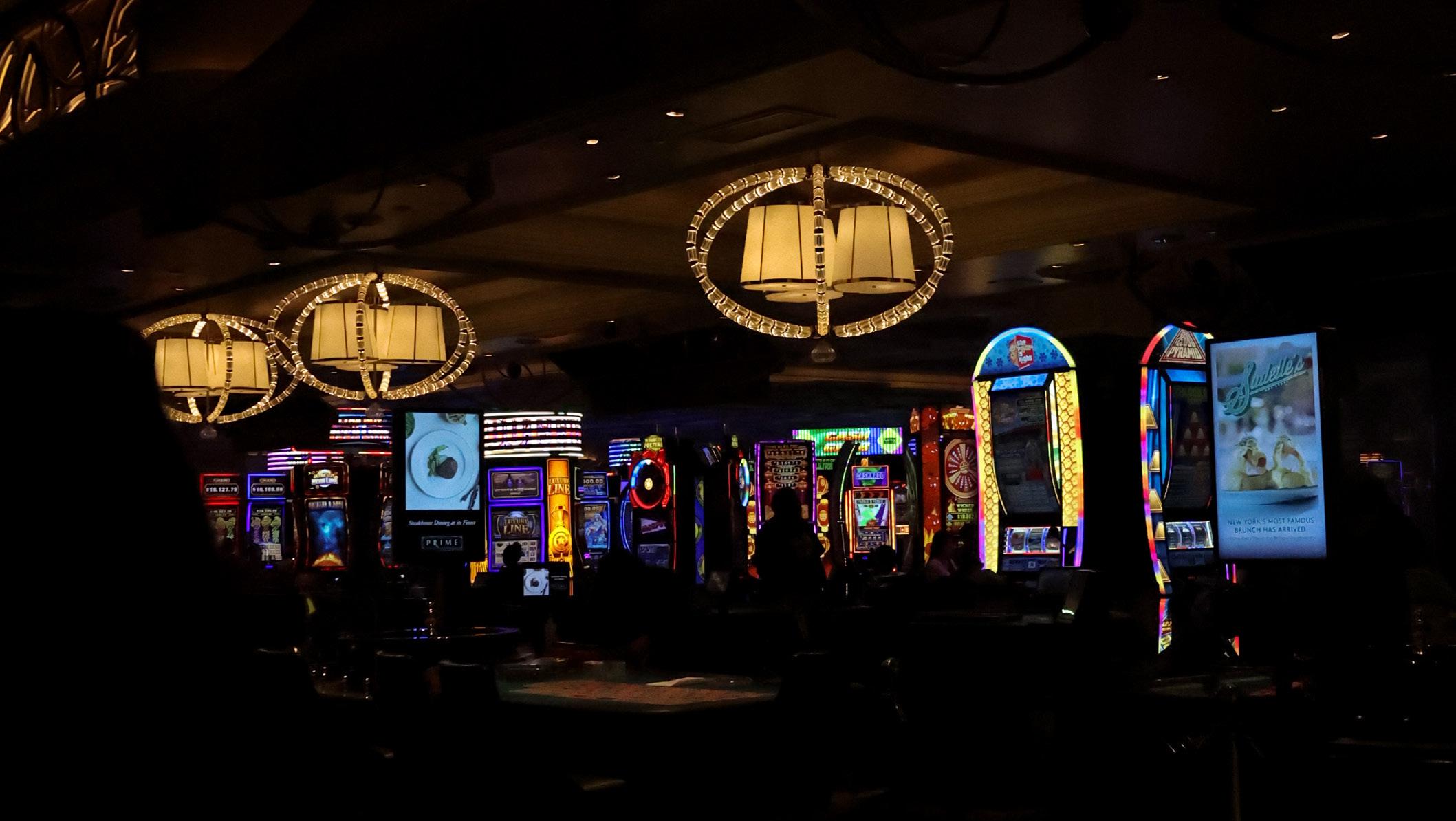
The hypnotic spirals on the carpet lure us toward the infamous slot machines. The gambling floor reeks of cigarettes, the machines emitting a cacophony of jingles, explosions, pings, pops, and electronic music. As we snake around them, Paradise’s notorious gambling allure reveals itself to be a grim sight. Gamblers, mostly middle-aged or elderly, sit gaping and unmoving, swimming in their screens.
I am reminded of the infamous casino sequence from the 2010 film Percy Jackson & The Olympians: The Lightning Thief. Percy, Annabeth, and his satyr sidekick Grover are lured into the Lotus Casino. The trio eat sugar lotuses and party for what only seems like a few hours, losing any sense of urgency for their quest.
51
However, they soon come to find those few hours inside the casino cost them days in the outside world.
The scene was based on the lotophagi myth from Homer’s Odyssey, a people who lured sailors to their island and fed them enchanted lotus flowers which dissolved any desire to leave the island.
While casinos are ordinarily meant to retain curious visitors, the decrepit expressions of gamblers trigger a visceral reaction in me — get out. There is plenty of crisp air to breathe, yet I can’t help but feel a sense of suffocation.
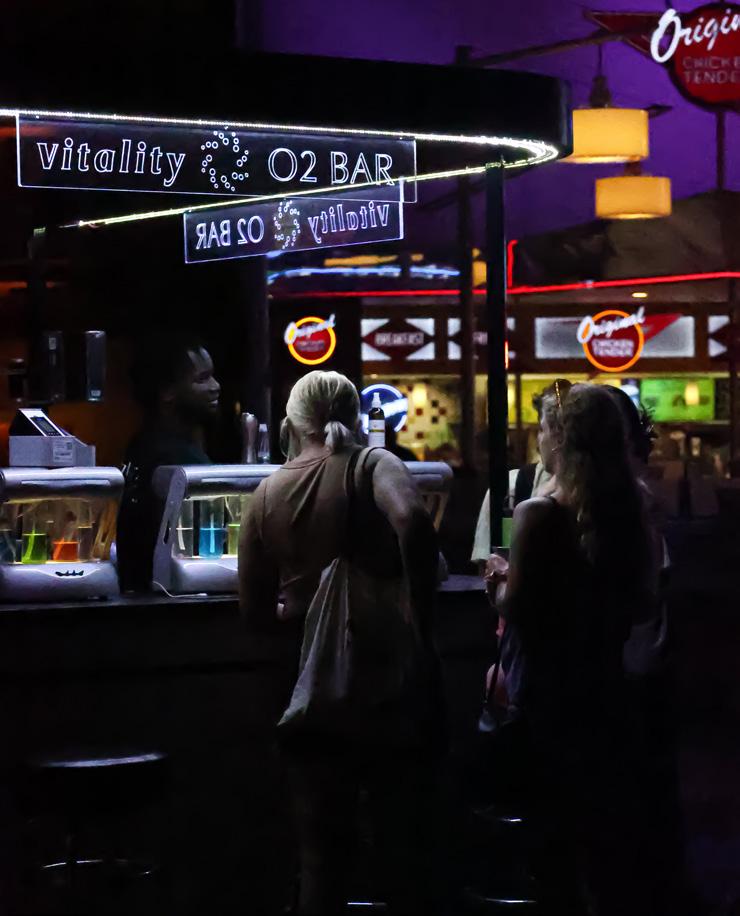
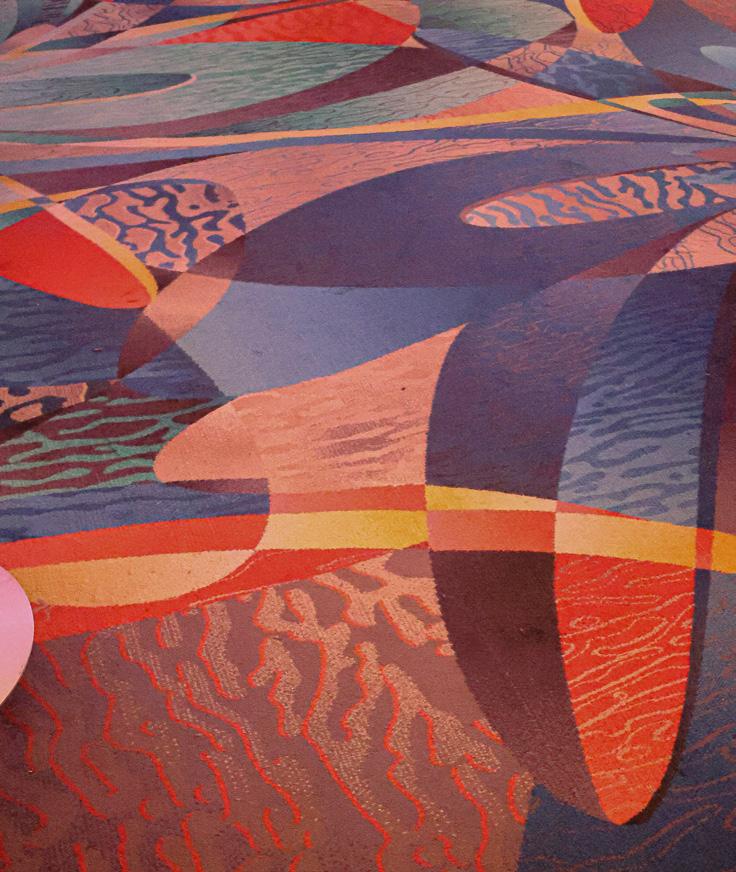
‘Fake’ is too simple a term to describe Vegas — the city demands language which encapsulates its problematic, precarious nature. The whole city is an assault on the senses, a crude collection of spaces: predatory design and architecture which disorients.
Undoubtedly, people are stuck in this city, but the question is: who?
Vegas, as a venus flytrap of a place, is not a new idea. It depends on the perpetration of addiction, and it preys upon those with a predisposition to it. Ordinary people have infamously wasted away in its halls, and even celebrity figures, like Elvis have signed away their freedom with artist residency contracts.
This exceptionally sticky city is also known for its ability to entrap people for not just a weekend, but for a good portion of their lives: not just tourists who decide to blow a paycheck or two, but artists bound to the city by contracts, workers who immigrated there to send money home to their families, and new residents of Vegas who swear they’re “not stuck” in the city.
We escape the Bellagio and barely make it inside Area 15, in fear of our tires popping on the burning highway.
Amid the blaring music, one young woman manages a line outside a gift shop, unphased by all the lights. She looks weathered around the eyes but smirks lightly as her coworker cracks jokes beside her. Jeany is a part-time student and nearly full-time employee at Area 15 for the past year. She tells me about the children she babysits at her other job at the casino next door.
“It’s crazy, parents can leave their literal babies, just like a few months old, with strangers to go and gamble. They go to different casinos, you know ‘cause each one’s got a time limit. Then they end up leaving them for up to five, six hours to gamble.”
We laugh at the absurdity of it all. She tells me she’s not stuck, that she’s got plans to “quit Vegas cold-turkey,” as in leaving for good. I wish her luck.
Infamous casinos
“The hypnotic spirals on the carpet lure us toward the infamous slot machines. The gambling floor reeks of cigarettes, the machines emitting a cacophony of jingles, explosions, pings, pops, and electronic music.”
52
I spoke earlier to another, older woman working at the same location. “Yeah, it would be nice to leave, but the money’s for my family.” She’s been working in Vegas for the last ten years. I hope Jeany can leave sooner.
There is even a darker side to people being stuck in Vegas: abductions are abundant. According to the Las Vegas Metropolitan Police Department, around 200 adults are reported missing every month.
One man working a flavored oxygen stand in the Luxor Casino leans in hesitantly when I ask him about it.
“There’s lots of kidnappings around here. So many abductions, you girls should really be careful.”
“We’ll stay in a group.” I try to reassure him (and myself).
“It doesn’t matter if you’re in a group. They’ll be in a group too.”
“Y’all probably didn’t know, the city tries to keep it hush hush, you know? So people keep coming back here and spending money.”
It was chilling to imagine the same adult amusement park
having such a seedy underbelly. I thank him. He tries to sell me the oxygen for the fourth time. Waving the tubes in my face he shouts:
“It’s like the stuff they give you at the hospital, but blue raspberry.”
As the sun sets, we hope that the temperature follows suit. But here we are in the dark, sweaty as ever. Amid the chaotic flashing lights and blaring music of the Strip, I picture what was there before. The rusty Valley of Fire. Then the ocean, the waves frozen into the distant cliffs.
There is something undoubtedly erotic about the eroded rocks, their smooth texture proof of the water and the wind loving so rapturously, they return again and again to kiss the cliffs.
A love affair; something stuck forever, and something visiting. Of return, of passionate attraction. A sort of fated stickiness.
Vegas, I decide, is a sticky city. As we drive away, I can’t help but feel a sense of relief, imagining we have escaped the sweet, dripping jaws of some fatal carnivorous plant. Or mythical Greek beast.

53
Sonder
Grizzly Peak musings

Behind UC Berkeley’s football stadium and past Lawrence Berkeley National Laboratory, alongside the estates nestled into the hill’s embrace, Grizzly Peak rises. On any clear night, if you wind your way along the hill’s curve, the city unfolds beneath you bit by bit like a sparkling map, its largeness daunting, sundry magnetism breathtaking and big.
At night and from above, all cities look the same: lit up and shimmering with untraceable movement. The higher you go — the further from the people in rooms, and the room you woke up in, and the cracked cement streets of downtown Berkeley, WALK sign flashing red against the pavement — the more the city seems to expand, zooming out as you spiral upwards.
words
Vivian Stacy
photo Shayla Madha design Hannah Zhuang
54
With the trees dark around you, everything down there feels brighter. You can imagine it from an airplane. You can imagine it from a satellite — just a pinprick on a moving map. Floating, suspended up here, you can imagine crushing the city between your fingers. It makes you wonder at your own insignificance, makes you poke and prod at it gently — as if the four and a half million people beneath you only just came into existence a breath ago for your realization.

Standing a few steps from the hill’s dulled precipice, or perhaps crouching on a log, curled into your knees and shivering in the wind-chilled air, you feel like you could step off the side of the cliff and just walk right into the city’s reflection. Besides the sky, looming formidable and lightless in the background, the dark water of the bay is the only spot of blackness on the map that is spread out before you. Cleaving the lights in half, dividing Berkeley from San Francisco, it is split only by the long straight edge of the bridge.
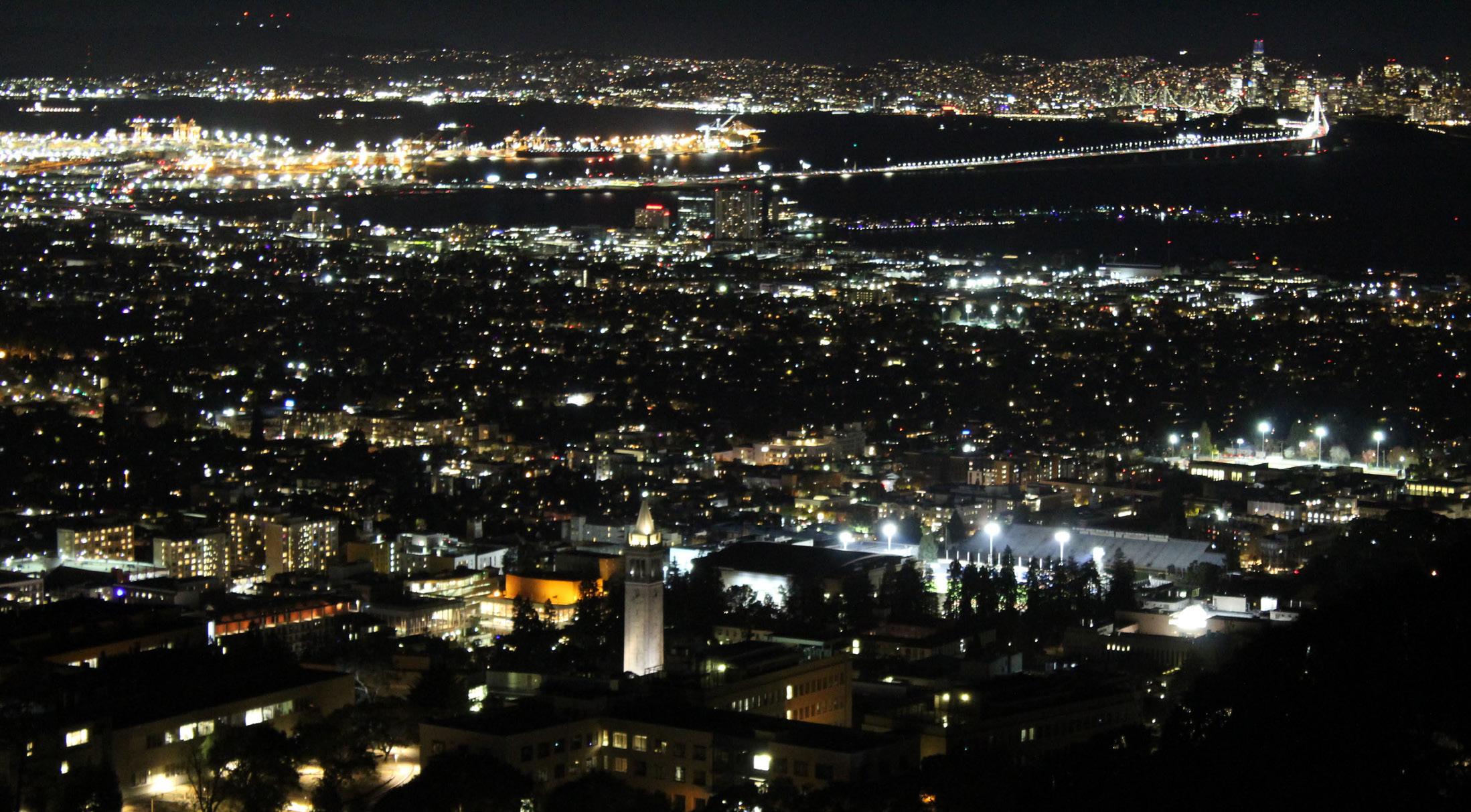
55
THE BERKELEY CONNECTION
The cars move across, glimmering faintly. Crawling along like metal-shelled beetles during the day, at night, they turn into red streaks of light, long threads of fate connecting strangers together by the thousands. The threads tangle, pulsating with life — each sparkle, each light just slightly out of focus, is a new life with an entirely different sense of personhood. The boundlessness of perspective is overwhelming, but also thrilling. The knowledge of your inconsequence washes over you soothingly.
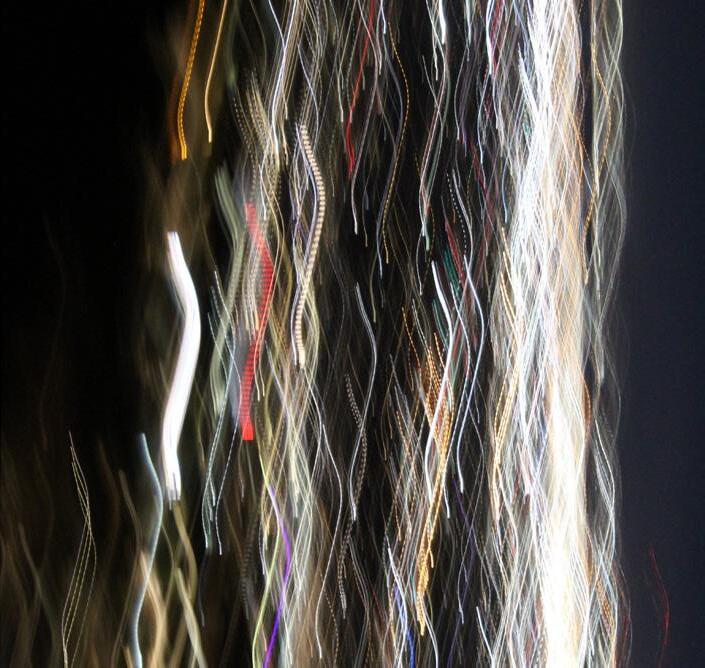
You think of Vegas, its capriciousness, its transience, foundation shaky and sunk shallowly into the earth’s surface. You think of all the people there, all coming and going, looping in and out of one another in an immense tangle of red thread, forging temporary connections that will be broken by morning, leaving behind a lonely frayed edge or the crease of an untied knot.
You can feel your own red thread, tugging on the end of your pinky. Intertwined immutably with Vegas’s constant ephemeral cluster, it winds its way up and down California, where it crosses and converges with hundreds of thousands of others.

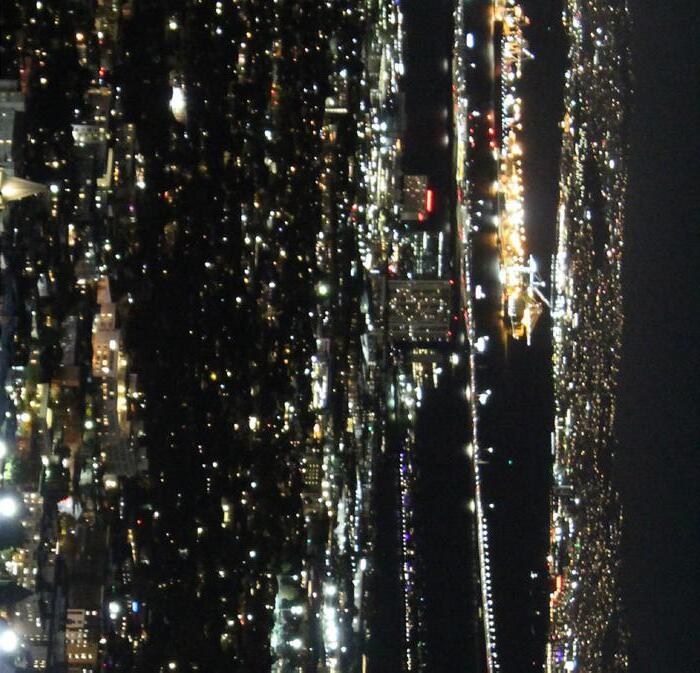

Light speed on long exposure paints the Bay Bridge with brightness; the hills rise around you, dark and comforting. The precipice you stand on is quiet — you breathe a little easier up here. Below you, people go on living. People are alive everywhere, and the stars show their faint faces everywhere, and from up here, the connectedness of the world is dazzling.

56
Only you could drag me to the barren wasteland where the sun’s wrath had scorched the earth
The purgatorial plain where terrain and hell meet But in the dehydration of life came your law defying birth

It was the desire for your embrace that could make me withstand the heat
Every inhale was a breath of fire that filled my lungs with stagnant burning
But not even that could crush my desire
For whom I was yearning
Your siren symphony filled my ears
And lured me from my happy home
I kissed goodbye my lover’s tears
So I may pursue you alone I hated it here But here I am Just for a chance to dance upon the palm of your pretty hand
You sparkle in a way that is too beautiful to ignore With ethereal features that of lore You didn’t just capture my attention
You ripped it from my core I couldn’t help but to study every inch of you
And get lost in your dirty emerald eyes But I could not stare for too long For risk of being hypnotized
I envy the long dark locks that get the pleasure of gently kissing your hips For I did not know obsession until I tasted it on your lips And when those lips part A voice that could only be described as the harmonization of angels emerged I had no choice but to abandon myself to your words
words
Shayla Madha
photos
Shayla Madha
design
Haniqa Rahardjo
Sinsatiable
A rush of immense happiness filled my being Whenever your eyes met mine
All I wanted was to be worthy of even A fleeting thought through your immaculate mind When those captivating eyes closed at night I thought I was saved from their radiation but then red flushed your cheeks And revealed freckles aligned more beautifully than the constellations So even when I was due for sleep
I did not dare close my eyes Because every second of your graceful slumber Was worth all my sleepless nights
vvvvvvvvv
57 NON-EDITOR CONTRIBUTIONS
I cannot bear to hide my desire anymore
I long to stain my lips with the red on yours
For mouth to meet body
Would be a rapture of my soul
And I your gluttonous diner
Begging to devour you whole
An ocean of emotions is swelling behind my dam
If indulging myself in the paradise that lay within your walls is a sin
Then sinner I am
I want to tempt you but you aren’t just void of lust
You control it
And your attention goes to those who put their fate in their hand And roll it
But I could save you from the greedy man
Who wants you all for himself
Because where I see your beauty
He sees wealth
I implore you, abandon this slothic wreck

Before I rip those fake pearls off your But for my devotion you don’t even care
I will never win
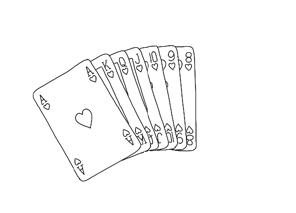
And now I think How many fools like me were there Longing for a delicate nymph that can never be obtained
So I’m sick of playing your games Stop pulling me in just to push me away
I reach for you but it’s no use You shy away but I know the truth

You don’t exist without me but I exist without you


In the end I am still yours No matter how hard I Your doors remain closed But I will continue to pry You could drag me through hell
And squander my pride
Two nights and a thousand kisses later
I’m still not satisfied
58
WWW.READCARAVAN.COM






























 William Fei design Hannah Zhuang
words William Fei photo William Fei design Hannah Zhuang
William Fei design Hannah Zhuang
words William Fei photo William Fei design Hannah Zhuang














 words Alexandra Jade Garcia
photos Apollonia Cuneo design
words Alexandra Jade Garcia
photos Apollonia Cuneo design






 Point Cloud
Point Cloud

























 words Nicole Ru photos Christina Kan Emily Langton William Fei design Christina Kan
words Nicole Ru photos Christina Kan Emily Langton William Fei design Christina Kan




















 photos
Christina Kan
design
Christina Kan
PHOTO SPREAD
photos
Christina Kan
design
Christina Kan
PHOTO SPREAD


































